Exploring the Amathole-Clur and Jamestown-Barker connections
(** denotes a direct relative of mine in the following text)
Gradually, as I pieced bits of information together about my family connections with the South African German settlers of the 1860’s, I started to imagine a visit to the Amathole mountains. I started off not knowing much about this line of the family at all, and most of what I thought I knew was based on word of mouth stories that were changed and embellished upon as they were passed on over the generations. Initially I was searching for two Clur brothers who supposedly came over with the German settlers. I found one Clur, **Johann Michael Clur, my great, great, grandfather, who came to South Africa, not as one of the German emigrants of 1858-61, but rather as a soldier in the D legion of British German Legion who arrived at East London in January or February 1857. These mercenaries were brought to South Africa to form a protective front between the already present colonists and the Xhosas, (see also **Johann Michael Clur – 1830-1902 ). My cousin Annemarie Xavier, (great granddaughter of Johann Michael Clur), recently told me that she had once visited the Frankfort Cemetery in the late 80’s with her mother, Getrude (“Gertie”) Renetta Wulff (nee Clur, 1909 – 1996). Gertie was the third child of Johann Michael’s third child, August Carl Clur and Marie Augusta Pahl. Annemarie saw the tombstone of Johann Michael Clur and also informed me that besides the 10 children mentioned in Johann Michael’s death certificate, the couple also had twins Matthaus and Martha. ‘Till then I had found no evidence of their existence. So, it seemed logical and appropriate, while visiting my South African family this year, to take a trip up the Garden Route ending in the Amathole mountains. I wanted to see the graves of Johann Michael Clur, his wife **Louise Wilhelmine Flieth – 1845-1928 and the twins. By seeing their grave, I would have obtained first line evidence of their existence.
23rd March 2024: Plettenburg Bay
Wilfried Visser (my partner), my almost 91 year old mother, **Denise Clur (nee Barker) and I, set off from Cape Town in the early morning. We followed the N2 along the Garden Route in an easterly direction. Our first pause was at Swellendam where we had coffee and a bite to eat at Tredici, a restaurant/ coffee shop/ kitchenware store. Unexpectedly, something dripped on the table in front of me, just missing my plate. I wondered if it was candle wax, but when I looked closely, I saw that it was a white slimy substance, very much resembling bird droppings. “But that’s impossible”, I thought, – “a bird in a restaurant?” I looked upwards and saw a large, black metal, double layered chandelier above me. And yes, there perched on the top was a bird, it was a fat titmouse! When I informed the waitress, she was not surprised or perturbed at all. She informed me that the birds come in all the time and fly around. On our way back to Cape Town 5 days later we stopped again at the same restaurant, and there my bird was, perched on the chandelier, obviously very happy in his house, singing and preening his feathers as if this was absolutely nothing out of the ordinary!
The first night we stayed at Robberg near Plettenberg Bay. The very first holiday that I went on with friends and without my parents, was to Plett at the end of my first year at university (1981). My father, **Dennis Clur, insisted on personally talking to all the boys who would also be going before he allowed it. Much to my embarrassment at the time, he
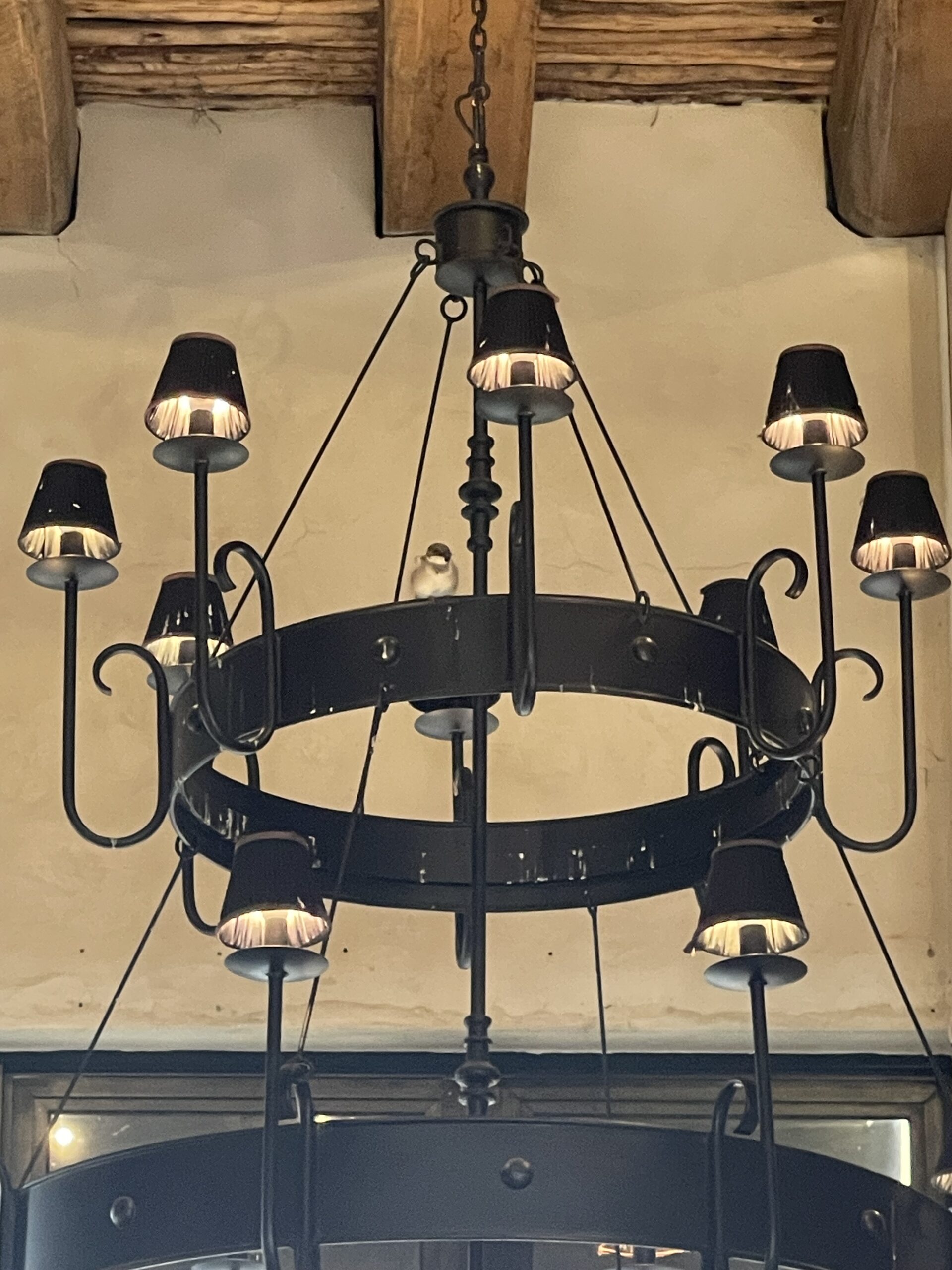


made them promise that the boys and the girls would have separate tents and that this separation would be respected throughout the stay. I fondly remember the long walks along the white sandy beach from the caravan park towards the Beacon Isle hotel, looking for Pansy shells (we never found any), lazing in the hot summer sun and eating ice-cream and bunny chow on the beach. We spent one night in a fishing hut on Robberg Island and marveled at the stars in the dark sky. Under the influence of Mary Jane, the boys gave a running commentary as Orion apparently killed the crocodile while the Southern Cross looked on. I, being a non-smoker, could not quite work out where the crocodile was, yet it seemed to be blatantly obvious to the others! We were less enthusiastic the next day as we all had been bitten by some sort of bedbug or sand fly and were covered in red itchy bumps that irritated us for days thereafter. This time, we spent the night at a very pleasant guest house, “Cottage Pie by Robberg” which was a major up-grade from my first visit to Plett 43 years before!
24th March 2024: Port Alfred

After Plett, we followed the N2 again for a while and then took the R72 to our next stop, Port Alfred. We had initially intended to stay at Kenton on Sea, as my mother used to go to Kenton every year for the summer holidays when she was a child living in Peddie. Her parents slept in a homemade caravan called the “Pea Green Monster”, and the three kids slept in a tent in the caravan park. Wilfried who was in charge of organizing the accommodation, found a better location in Port Alfred however. We stayed at The Beach House overlooking Shelly Beach which was run by the very welcoming and chatty, “Isabeau”.
This too brought a mass of childhood memories rushing back. We spent almost every December school holiday at my grandfather, **William Edward Barker’s house at 37 Alfred Road, located on the hillside to the east of the Kowie River. As mentioned in the introduction to this website, this was a time when the whole family came together. My great aunt ’Rene Johnson (nee Watkins) came from Uitenhage, my great aunt Winsome Barker came from Cape Town and my first cousins (Mark, Tanis, Dorian and Lara Hopley) came from Port Elizabeth (now Gqeberha), with my aunt Betty-Lou (nee Barker), uncle Jimmy Hopley and all the dogs. We (my brothers Alwin and Gavin, myself and my parents Dennis and Denise Clur (nee Barker) came down from Johannesburg, (Belinda Clur and Fred Hopley were not yet born). My great aunt Kate Watkins joined us too from Damot Lodge in Port Alfred where she lived. She always had a box of Smarties for each child and always tried to interest us into accompanying her to the Christmas service at the Anglican Church up the road. We all tried to avoid this, but she did manage to drag some of us off to church on occasion.
We loved going to Little Beach, swimming in the lagoon and sliding down the sand dunes on homemade hardboard “surf boards” at the East Beach. To catch little fish, crabs and squid we went scrambling in the Tidal Pools with our buckets and spades. My mother used the fresh octopus ink in her watercolour paintings. When we came back home my grandmother, **Doris Barker, (nee Watkins), insisted that we always hosed off our feet before entering the house. She was not having any sand in the house that was kept impeccably by Regina. Regina lived in the nearby township. She was amazing, bringing us tea in the mornings and cooking our meals. She was always so happy to receive us every year. The garden was a paradise of exotic fruit: oranges, lemons, guavas and granadillas. Sometimes we just lay on the grass in the sun. At home we had a thick kikuye grass lawn, here the kweek grass pricked a bit as one walked barefoot or lay on it. Between the grass in the front lawn, we sometimes encountered ‘dubbeltjies’ – small thorns, that stuck in our feet and were a painful irritation. In the valley below the garden was the railway line. When the train was expected to be passing, we would all run to the end of the garden and wave as the train passed as if enacting a scene from The Railway Children. At night my grandmother would read to us, I particularly remember her reading “Little Woman”. We all gathered around her to listen, our sunburnt faces gleaming.
My grandfather was an inspector of schools, as was his father before him, and he insisted on silence when the news was on the radio. He always took an afternoon siesta and he always wore a hat. Hats were essential – he had once got a fishhook in his head from another fishman’s “miss-cast” while not wearing his hat. He taught me to catch fish on a line and took us for trips up the Kowie river in his “Big Blue Boat”, where we caught large crabs for dinner. The fishing lines always got caught in the Seagull engine. He also made us a fantastic boat out of two tyre tubes with a box stuck on top called the “Mary Poppins” that we used at Little Beach. He kept chickens at the bottom of the garden. On one occasion after he chopped the head off a chicken destined for our lunch, it flew onto the roof. Getting the chicken down again was, I remember, quite a performance! One of the dogs that my aunt Betty-Lou (Elizabeth Hopley, nee Barker) brought with her was Pompey. He was part ridgeback with a wide double ridge with the middle hair running in the opposite direction and little crowns all the way on both sides. She told me that my grandfather was terrified of Pompey and refused to step over Pompey when he blocked the passage. Instead, he stood there calling for help. Visiting ladies would nearly jump out of their skin when Pompey’s cold nose very gently lifted their skirts!
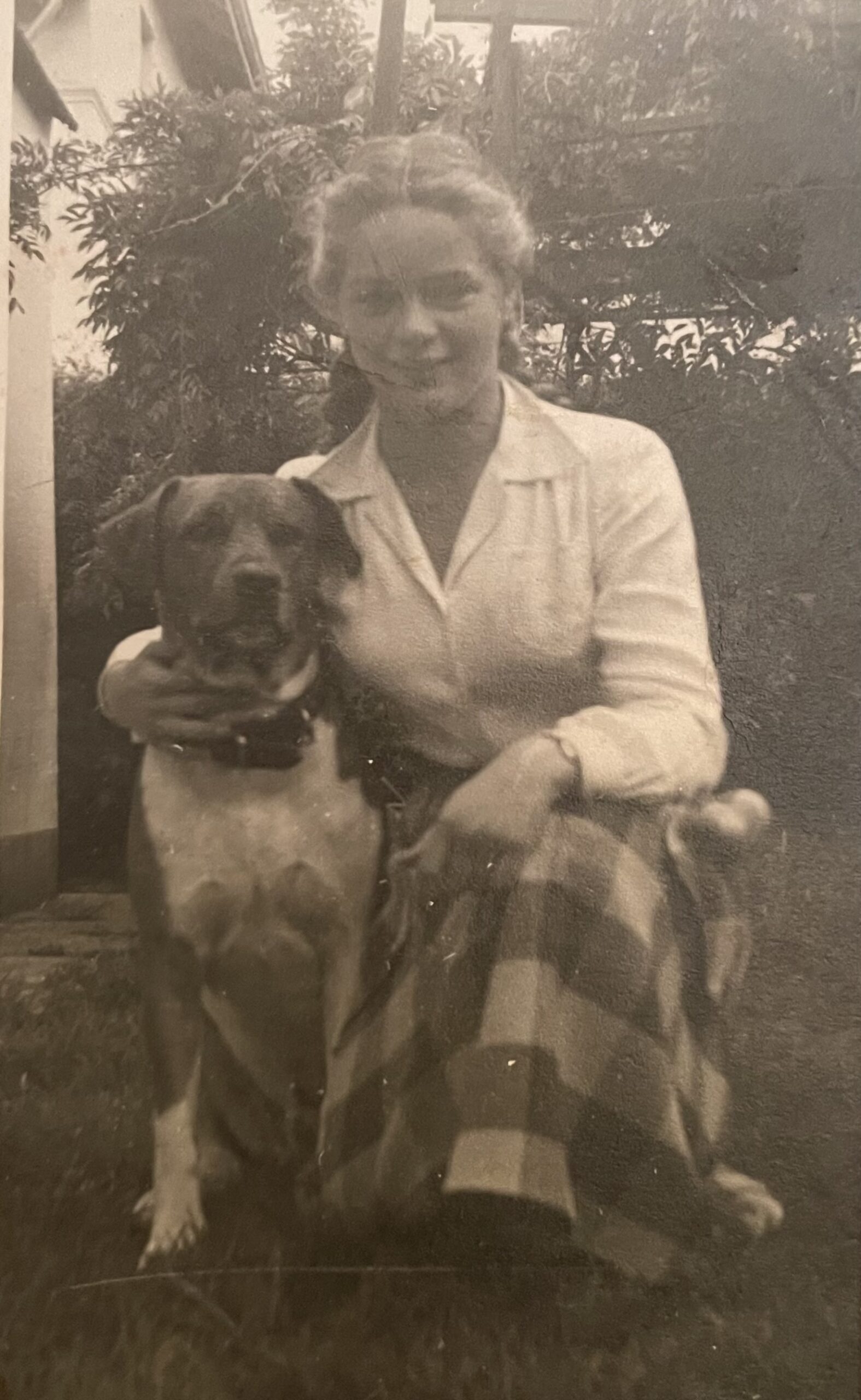
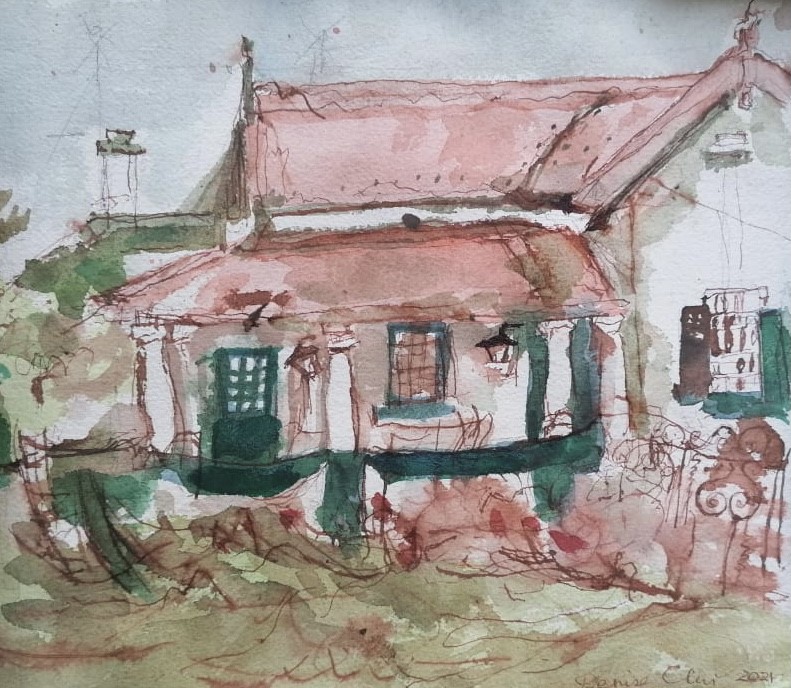
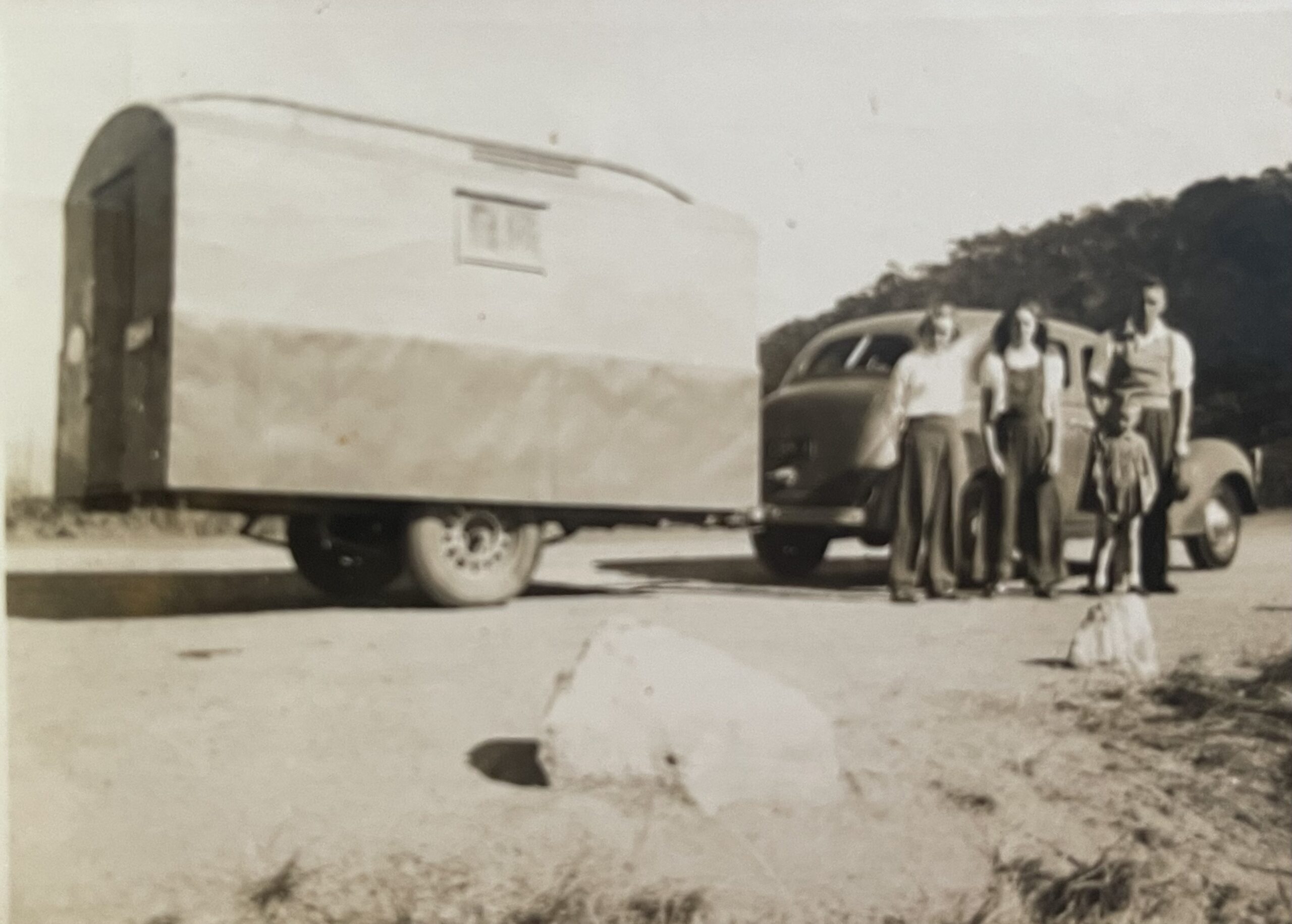


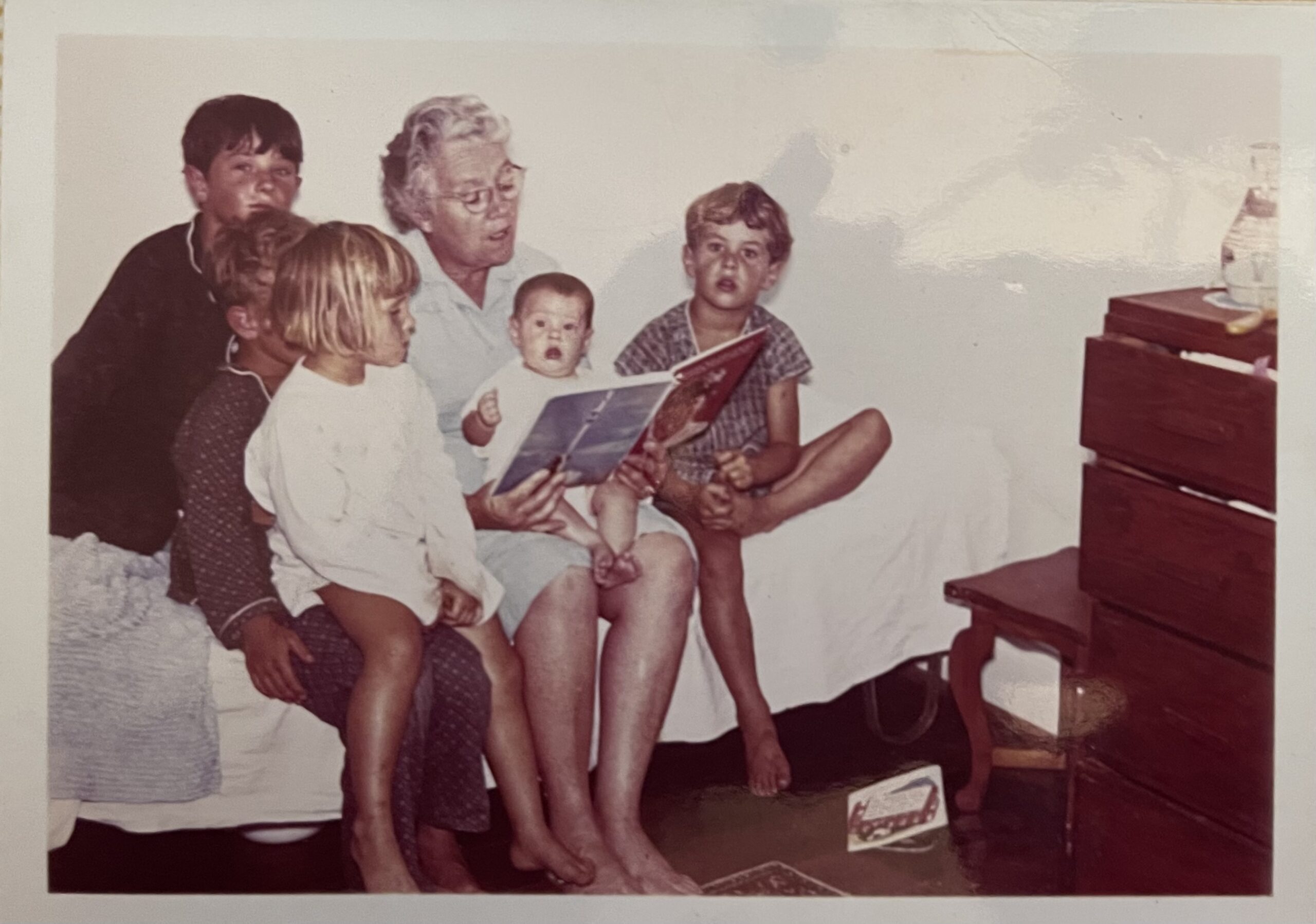

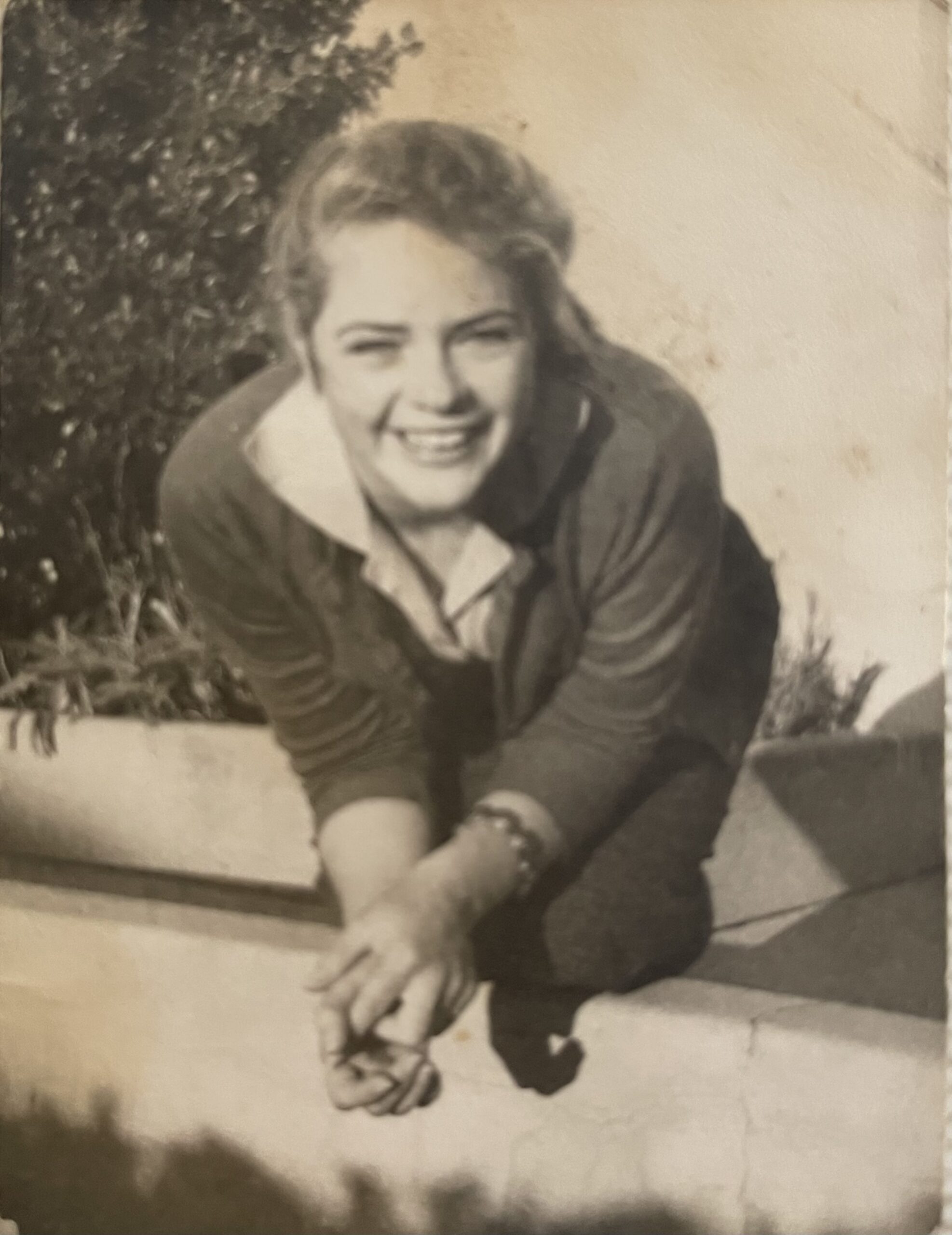
Despite many changes, the old Port Alfred was still recognizable. The then still undeveloped west side of the Kowie river where the golf course is, is now built-up. The east side is run down and in stark contrast with the new up-market marina. Revisiting 37 Alfred Road was a great disappointment. None of the charm of the old house remains. The house is walled in, linked to armed response and painted grey. The garden looked much smaller, a house has been built between what remains of the garden and the railway line, and I only saw one remaining lemon tree. The roads were in a poor condition with many potholes. Luckily redemption was found a little further up the road. The old Anglican Church that great Aunt Kate dragged us to, has been maintained beautifully.
25th March 2024: Amathole Museum and German Cemetery
Qonce, formally King Williams Town, was our next destination. We continued along the R72 for a while, before turning north along the R345 until Peddie, where we joined the N2 again and travelled in a north-easterly direction. We passed extensive road works along the way. These were irritating, but as Wilfried said, gave a positive sign for the future of South Africa. I have deep respect for the ladies standing along the roadside, waving red flags all day in the hot sun. The R345 was in poor repair, but travelling though the small towns was interesting. One had to be alert in order to avoid the people waiting for lifts at the side of the road, not to mention the sheep, goats and cattle wandering loose.
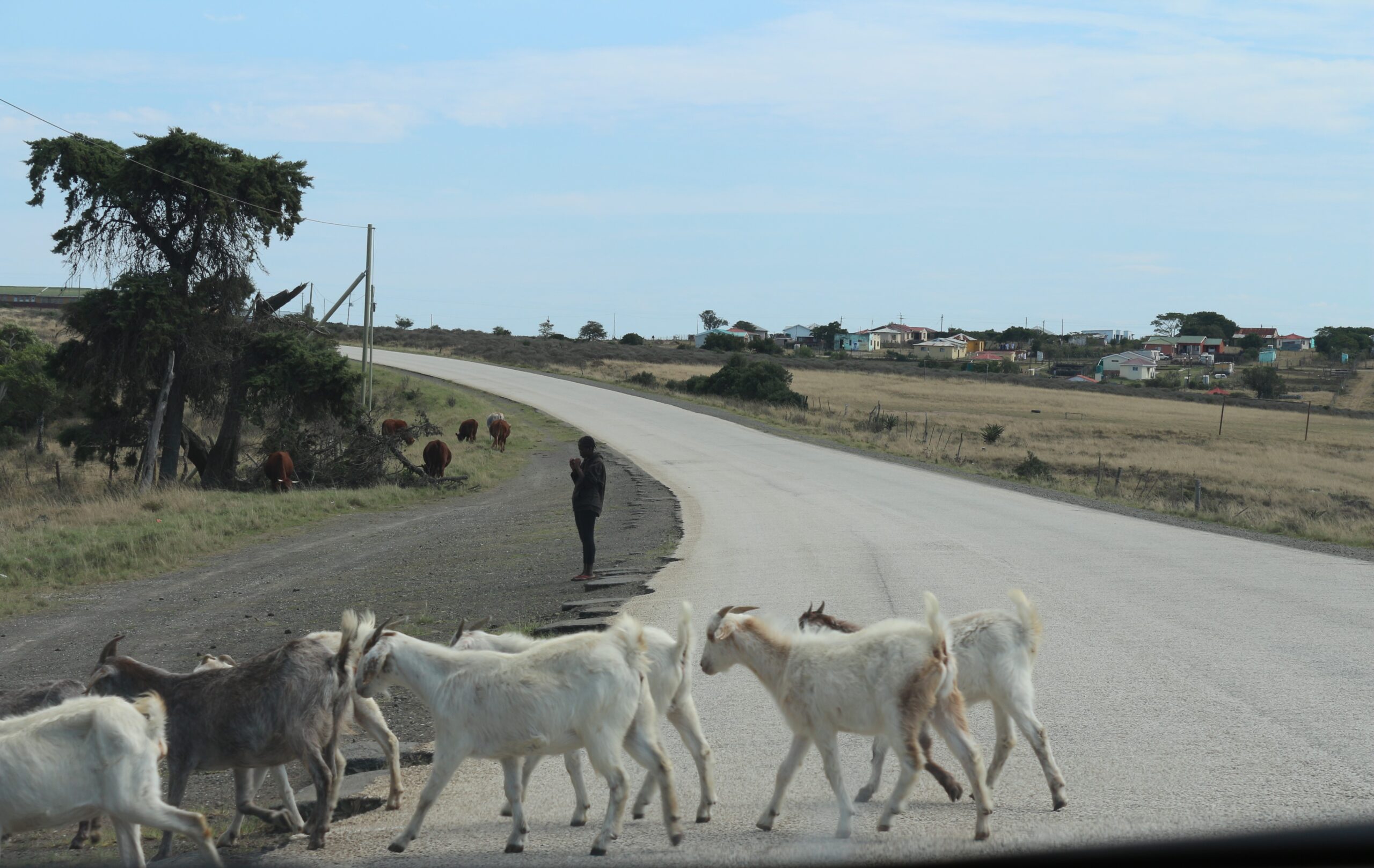
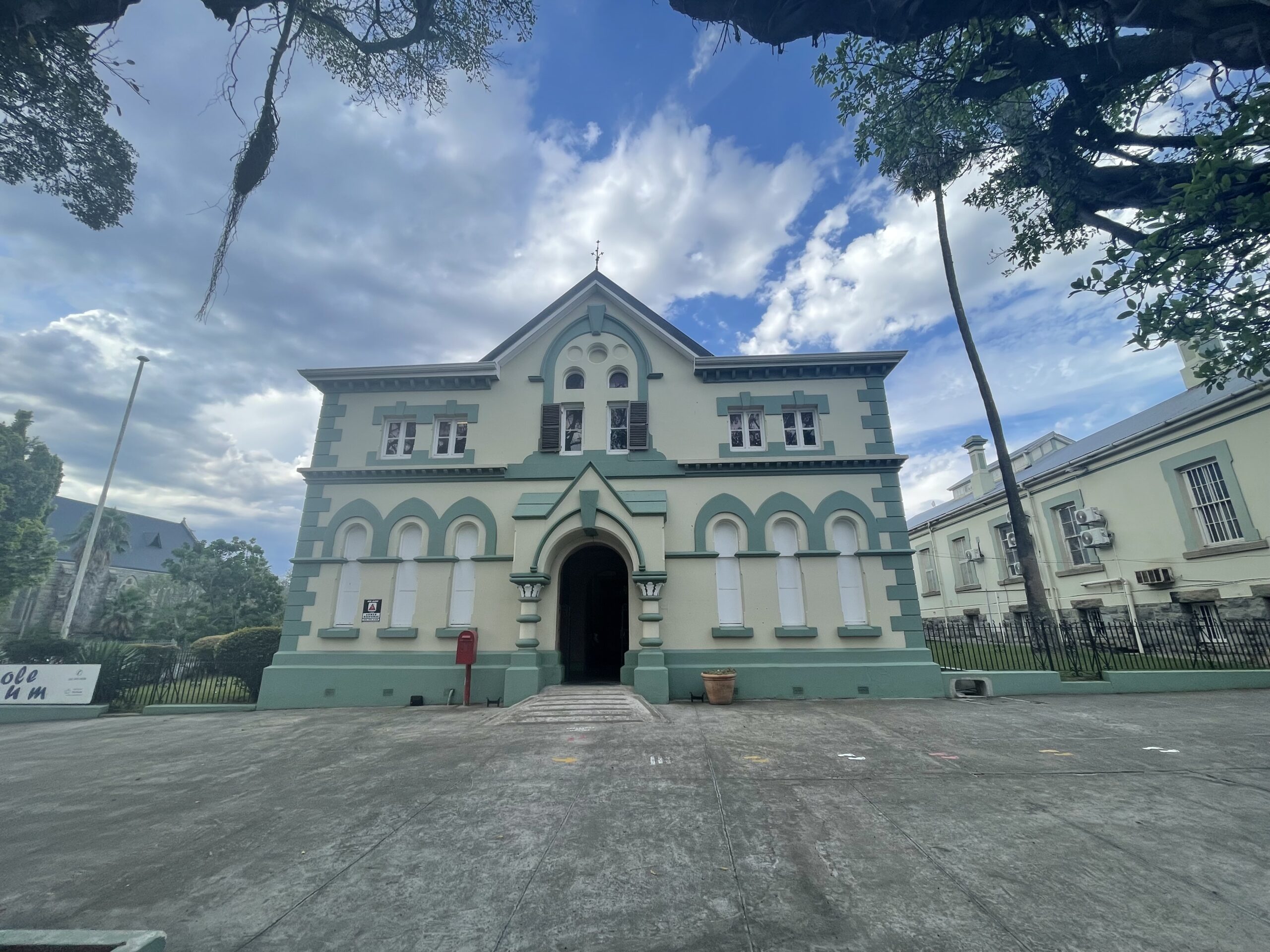
Qonce was hot and busy when we arrived. Not a single traffic light was working and the traffic was chaotic. Our navigation was not working as we had no mobile service and I was feeling rather flustered. So, we did not visit the house at 2 Taylor Road that August Carl Clur built for his daughter Gertie Wulff when she married. It is now being used as a medical practice. Luckily, we were welcomed at the Amathole Museum, and despite not having an appointment, historian Dr. Stephanie Emilia Victor made time to talk to us. She looked in the the museum files and databases for information about Pucherts and Clurs and shared some old photographs and collected anecdotes with us. (See also Carl Georg Puchert – 1834-1914 and In search of Carl and Wilhelmine. ) While at the museum we looked around and paid our respects to Huberta the Hippo who had strolled along the streets of old King Williams Town so many years ago.
In the Amathole Museum German archives there is an entry documenting information given by Gertie Wulff (nee Clur), Johann Michael’s granddaughter. She was led to believe that Johann Michael Clur was a Lieutenant in the Prussian army. He is said to have fought against the French. After he failed to pass an order onto his men that he thought would bring them into danger, he was demoted, but not executed, because the Prussians were victorious. Hereafter he emigrated to British Kaffraria. This, according to my research, is wonderful fabrication. The Franco-Prussian war was in 1870-71, 13 years after Johann Michael had arrived in South Africa! He came to South Africa as a member of the British German Legion. He was recruited initially to fight in the Crimean war but never saw combat. He was born in Welschneureut, the probably illegitimate son of **Catharina Clour (1806-1848). The identity of his father is unknown. When he was 7 years old his mother married Johann Peter Grether (Greder/Greter/Groether). Catharina’s sister Eva Clour married Johann Peter’s brother, Phillip Grether. When Johann Michael enlisted his mother was already dead. Johann Grether had just died in Algeria (on the 7th January 1856). See also The Clurs (Clours) of Welschneureut (1699-1860). According to the army records in Kew UK, Johann Michael Clur listed Phillip Kroeter as his closest relative and he was a private in the 4th Light Infantry. I thought that Phillip Grether and Phillip Kroeter must have been the same person. Support for this theory can be found in the Amathole Museum’s German database where it states that Johann Michael was a corporal in the D Legion, of regiment 2, company 2, and that his nearest relative was Peter GRETER. (see also **Johann Michael Clur – 1830-1902) .
August Carl Clur, Johann Michael’s third child, had three wives. He was also brave as a child. In the Amathole Museum Records, (German database), Gertie Wulff tells of her father August Carl Clur’s encounter with a few assegai-wielding Xhosa warriors while herding the cattle at Frankfort as a child. This must have been a harrowing experience for a young white boy on the frontier at the time. August Carl is said to have made a gesture as if be calling his ‘back-up recruits’ to came and arrest the Xhosa warriors. They found his acting so convincing that they dropped their spears and ran away! August Carl showed the assegais to his alarmed mother later when he returned home with the cattle.
The Clurs were Baptists and the German Baptists had issues with the German Lutherens. This lead to the exodus of some German Baptists to Johannesburg. My great grandfather **C(K)arl Friedrich Clur – (Johann Michael and Louise Wilhelmine Clur’s oldest son), went to Johannesburg to work on the railroads. According to the Bethany Emmanuel Baptist Church database, he was Baptized on the 6th June 1886 by Rev. Gutsche. His address at the time was given as Frankfort and it records that he transferred to the Johannesburg congregation in March 1890. He was thus one of the Baptists that left the Frankfort community and probably joined the Fordsburg community. He lived in Troyeville. My father, **Dennis Clur was brought up as a Baptist, but later became disillusioned and areligious. I remember finding his Sunday School certificates in a box of things that were sent up to Johannesburg from my grandfather **Alwin Bernard Clur’s house when he moved back to Johannesburg after his wife Chrissie Clur (nee Cockrell) died. The pictures of the Fordsbrug Baptists where given to me by the Amathole Museum historian Stephanie Victor. (see also Carl Friedrich Clur (1861-1913 ) and Louise Caroline Puchert (1865-1953)
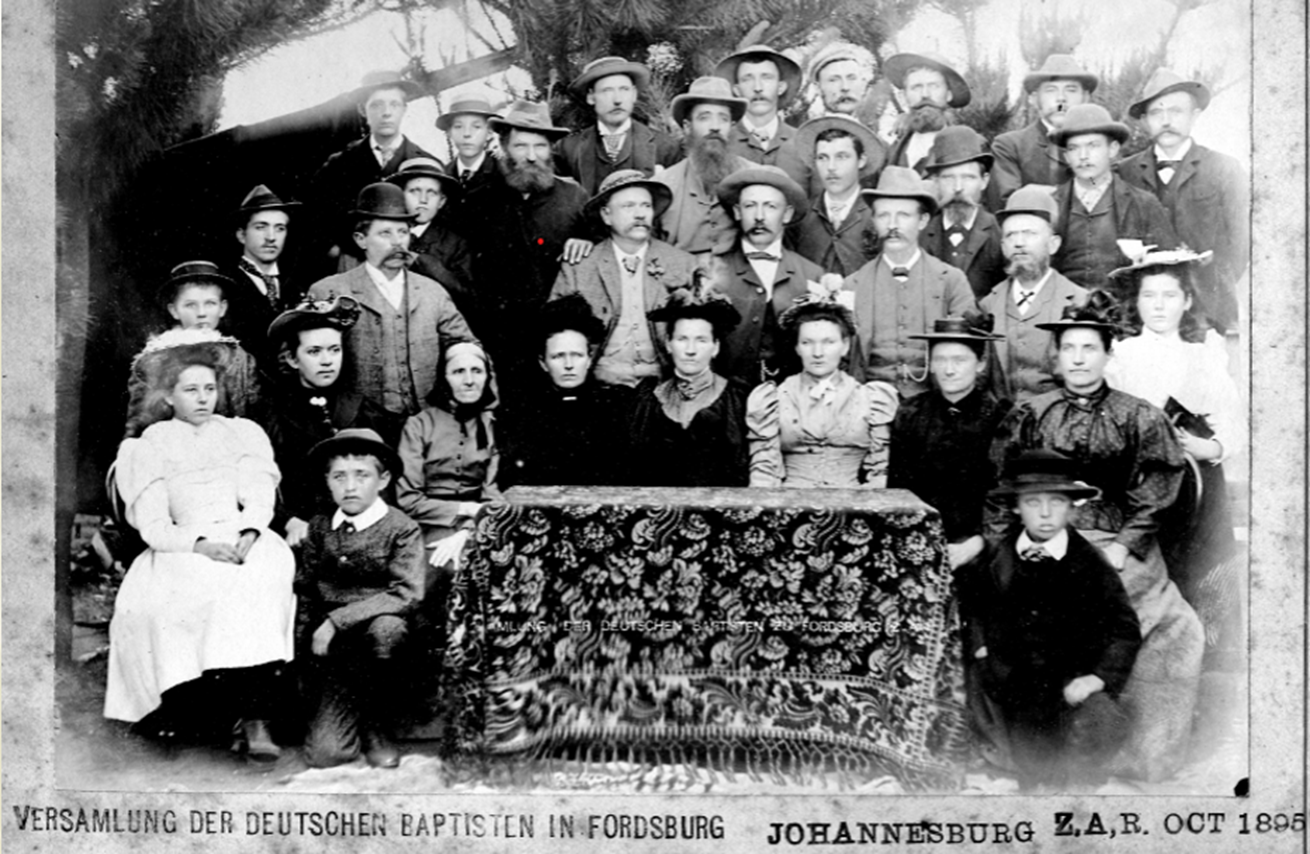
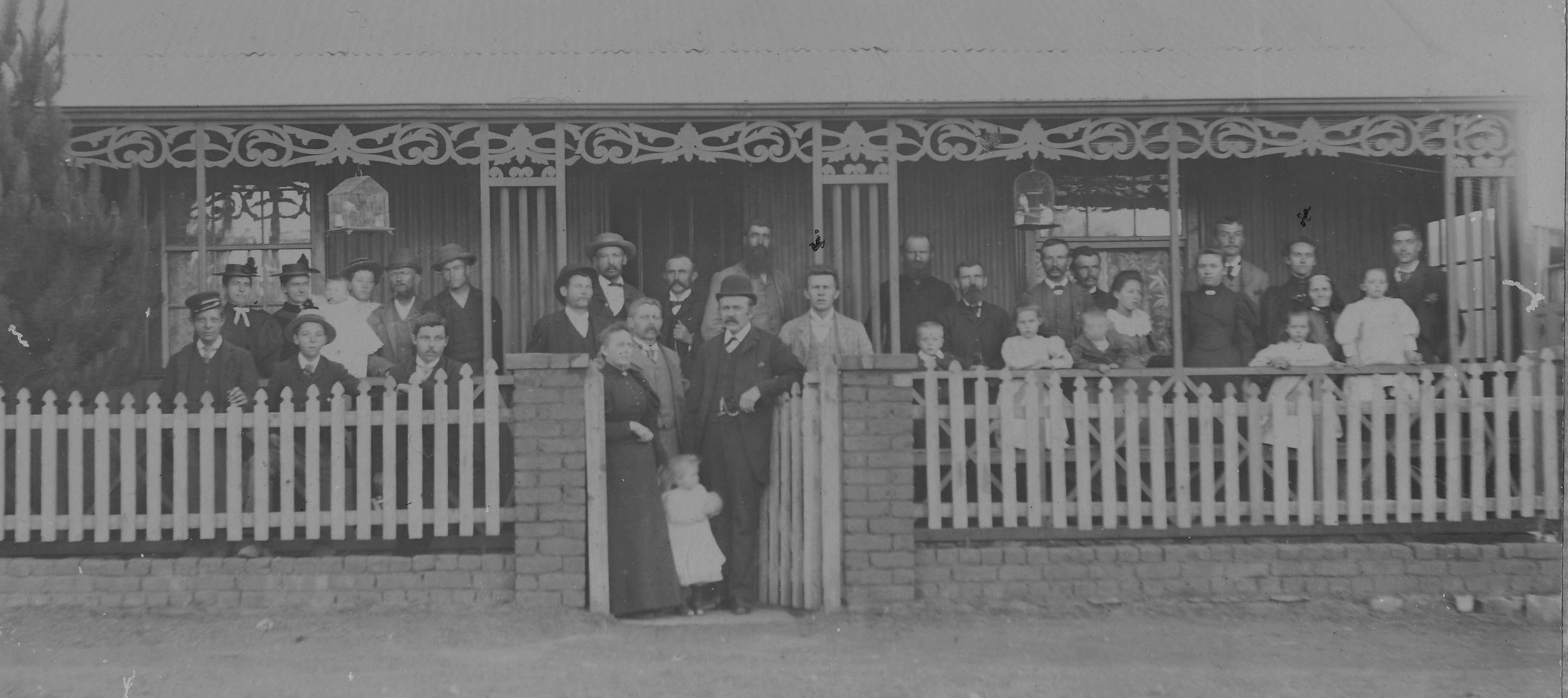
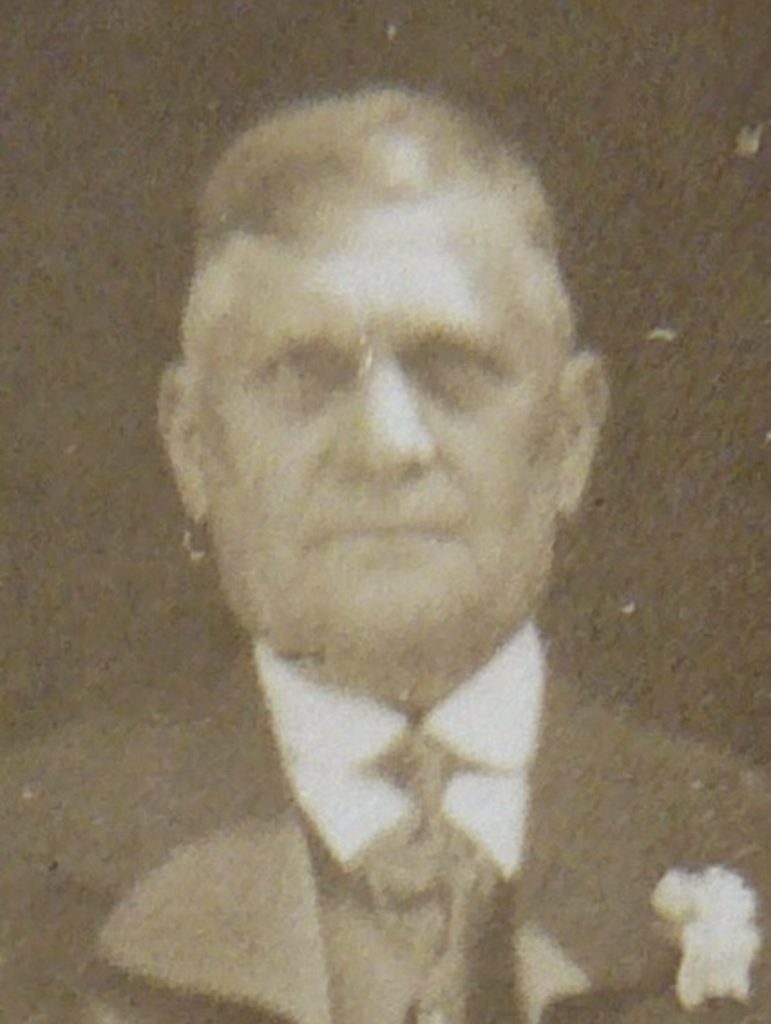
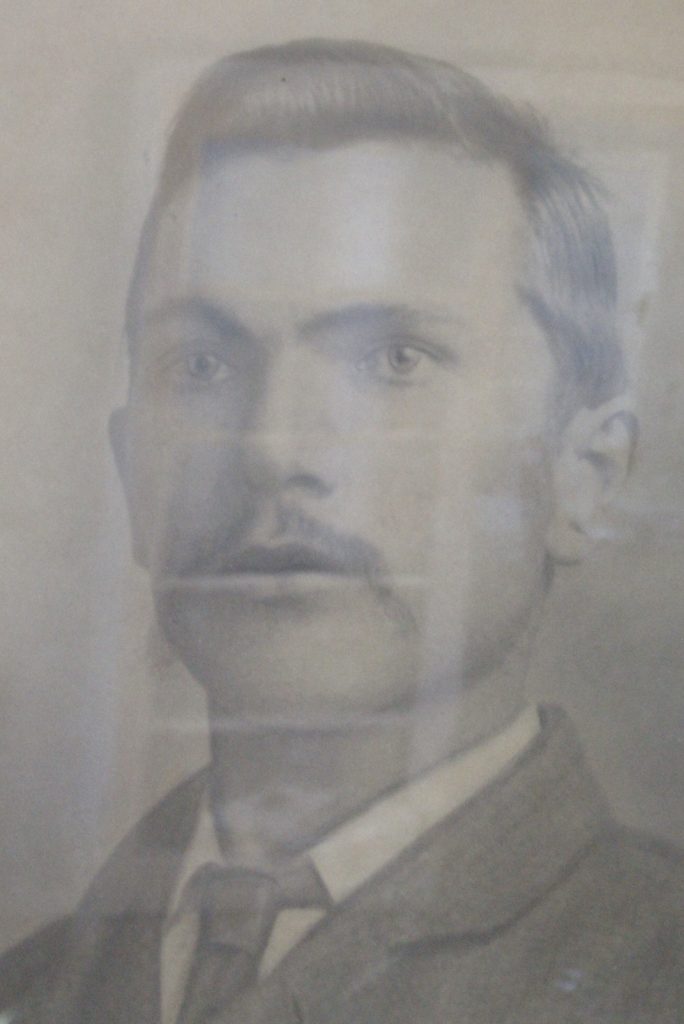
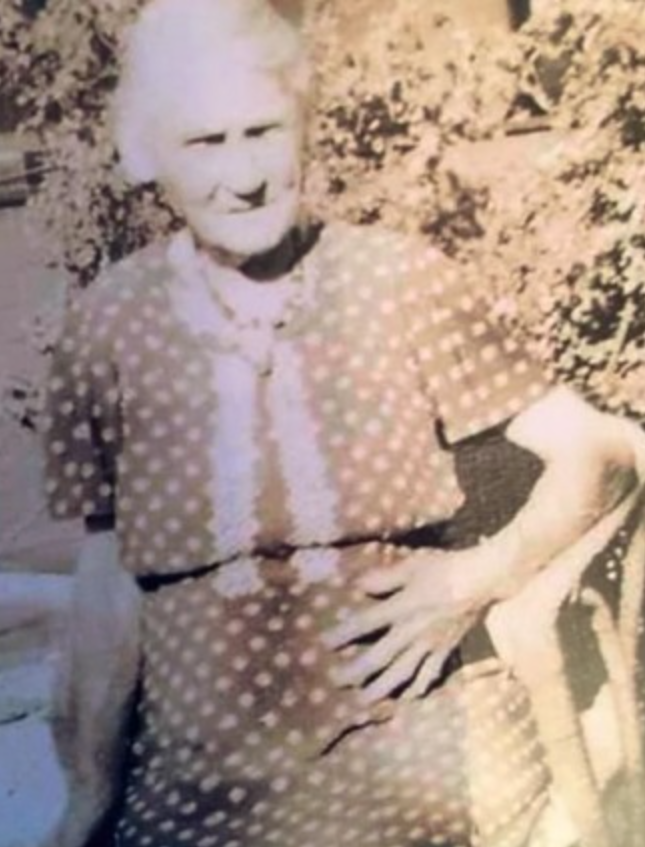
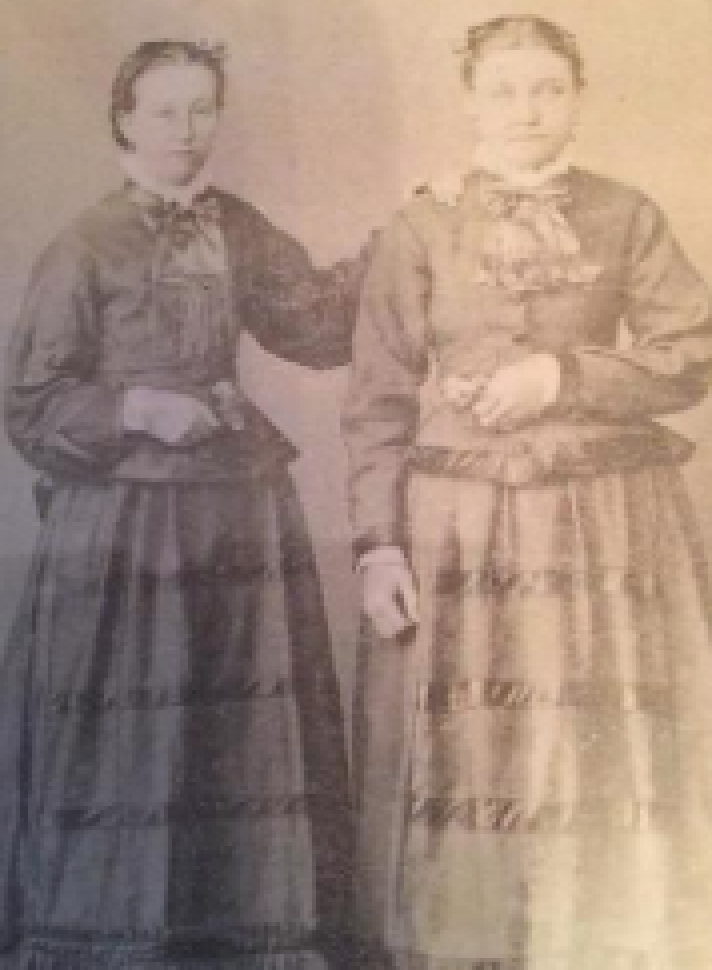
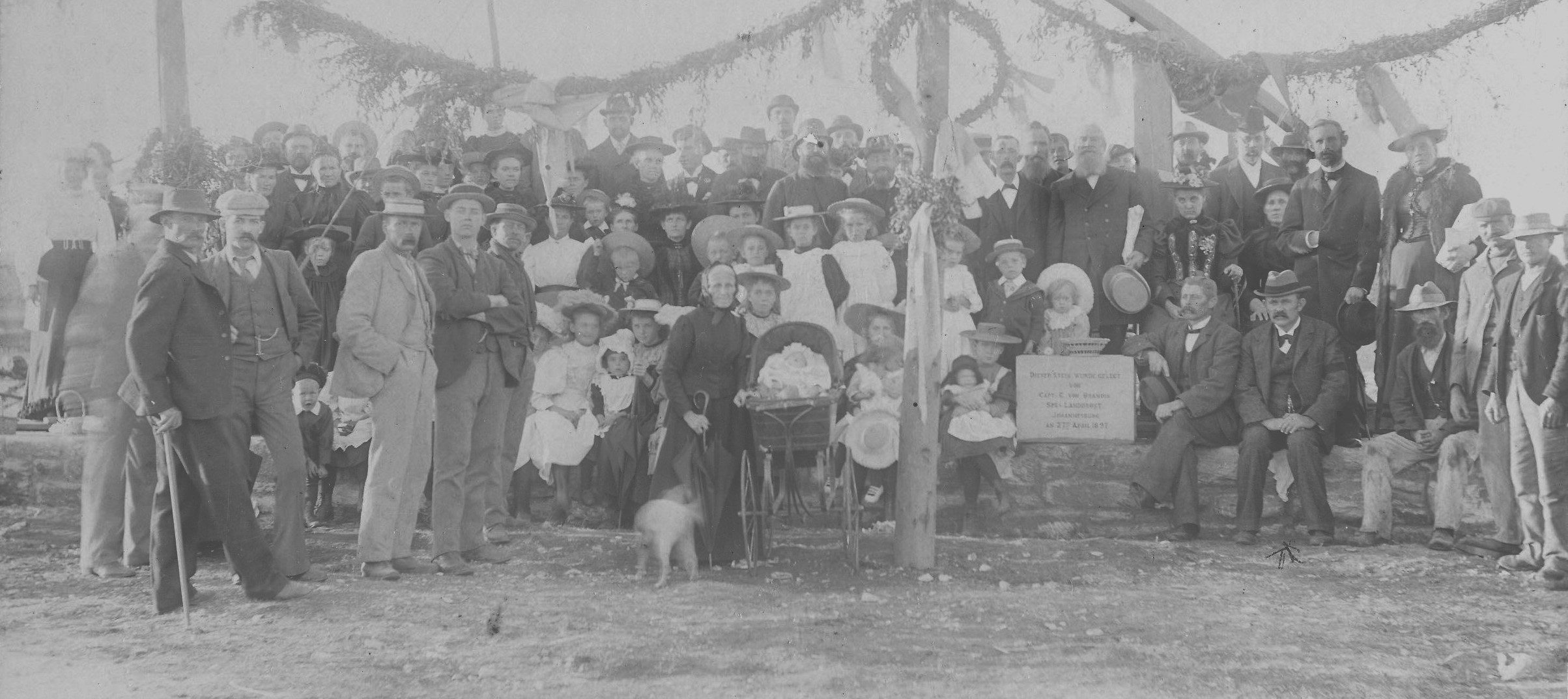
We were warned by a local who has been living in the area for many years, not to go and visit the German Cemetery in Frankfort. It was risky, and the cemetery was likely to be overgrown and unwelcoming. Also the roads were said to be poor and a 4 wheel drive vehicle would probably be needed. If we really wanted to go, we were advised to hire a guard in Qonce for protection during the visit. I have never been afraid when visiting graveyards, I have always found them interesting and fascinating places. Also, ancestors are sacred and revered in many African beliefs, so I imagined that the graves would not have been ransacked or deliberately damaged, and somewhat naively perhaps, that visitors would not be interfered with. I was, thus somewhat taken aback by this comment. I gathered later, however, that when my cousin Annemarie Xavier visited the King William’s Town Main Cemetery in 2007, all the trees had been cut down – apparently as thieves had been hiding behind the trees and stealing cars and other things from people visiting the graves. We decided to continue on our course nevertheless. My mother proposed “banana”, when I suggested we make a “get away now” or “run” codeword, just in case.
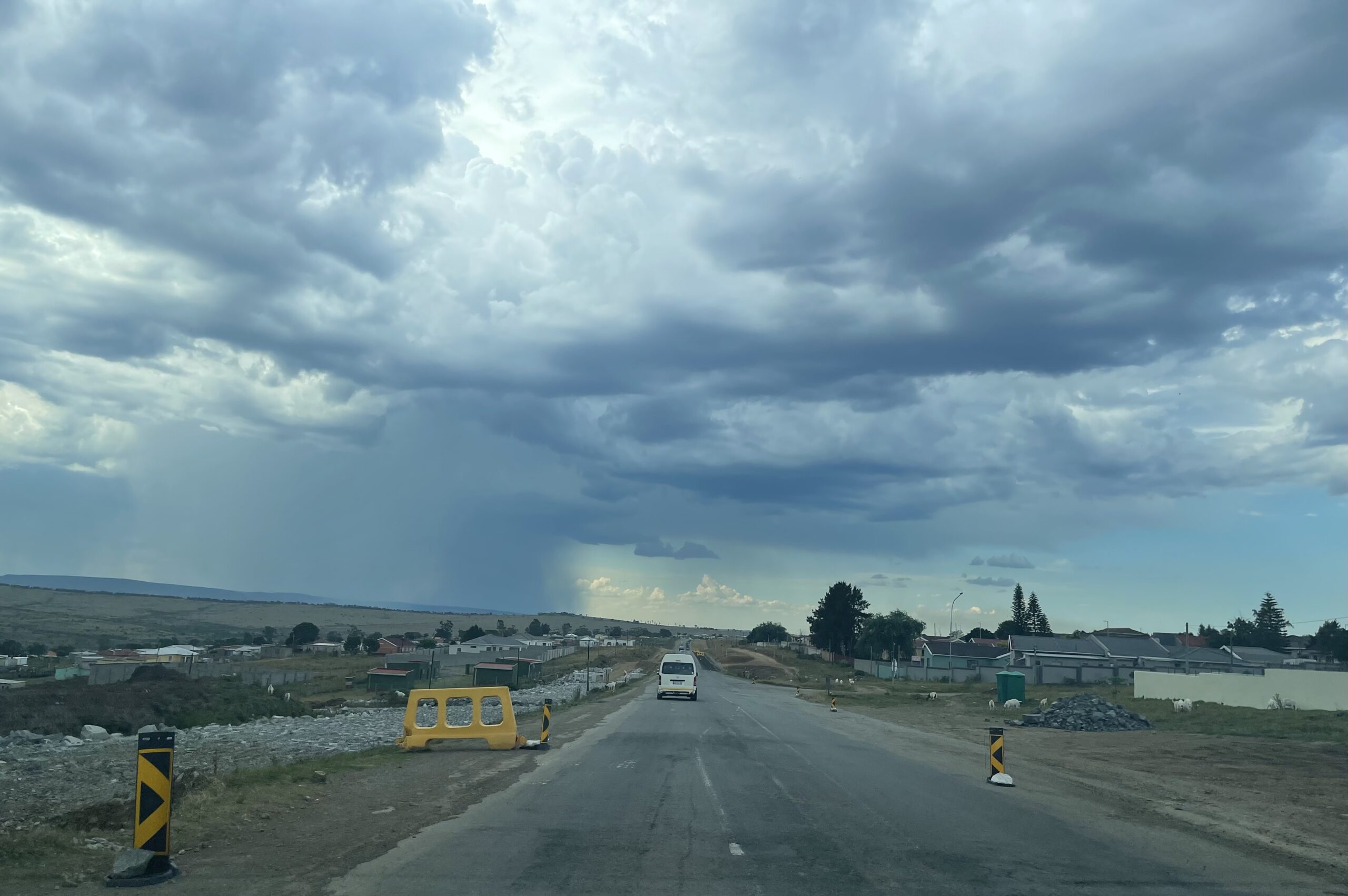
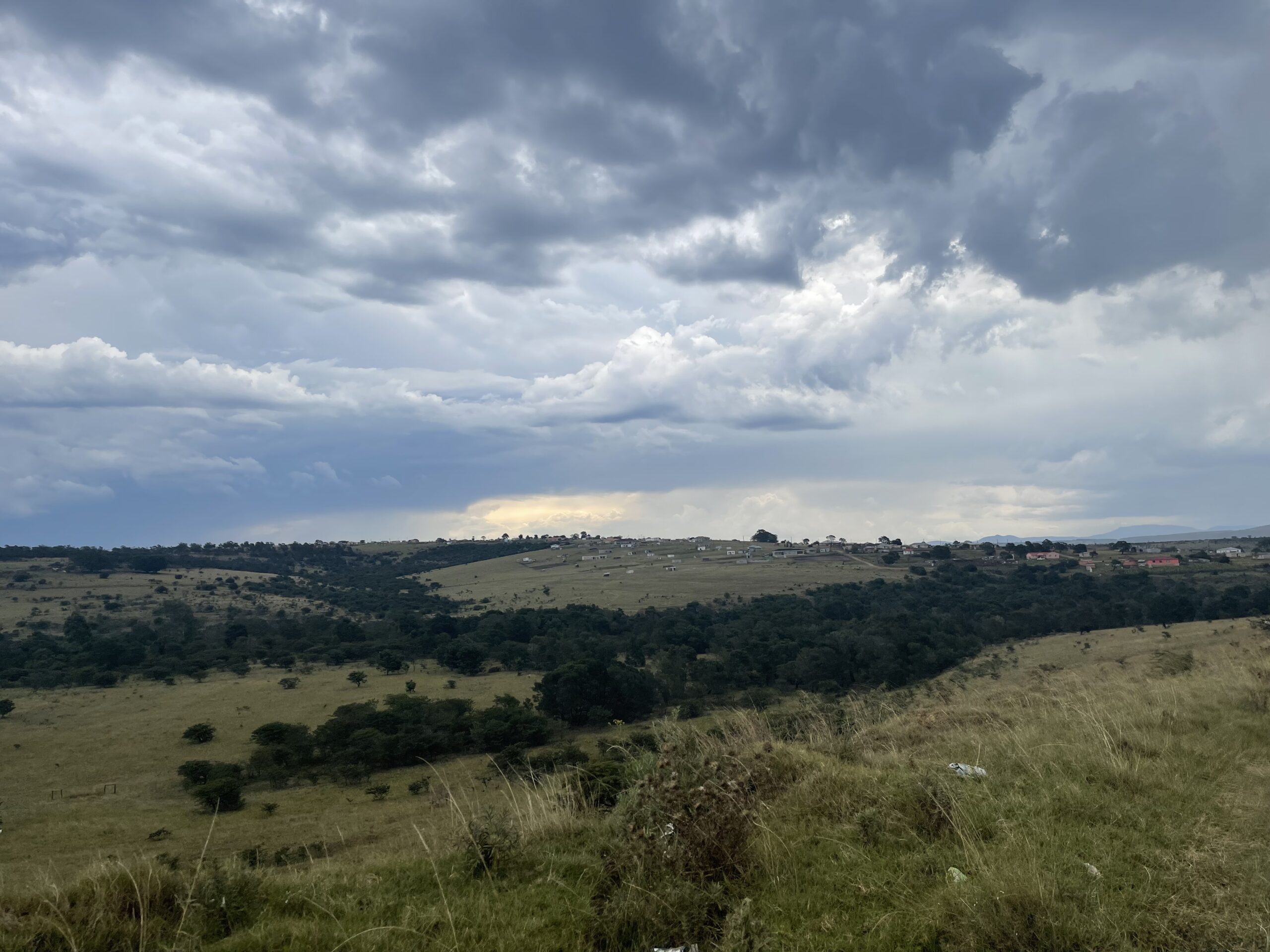
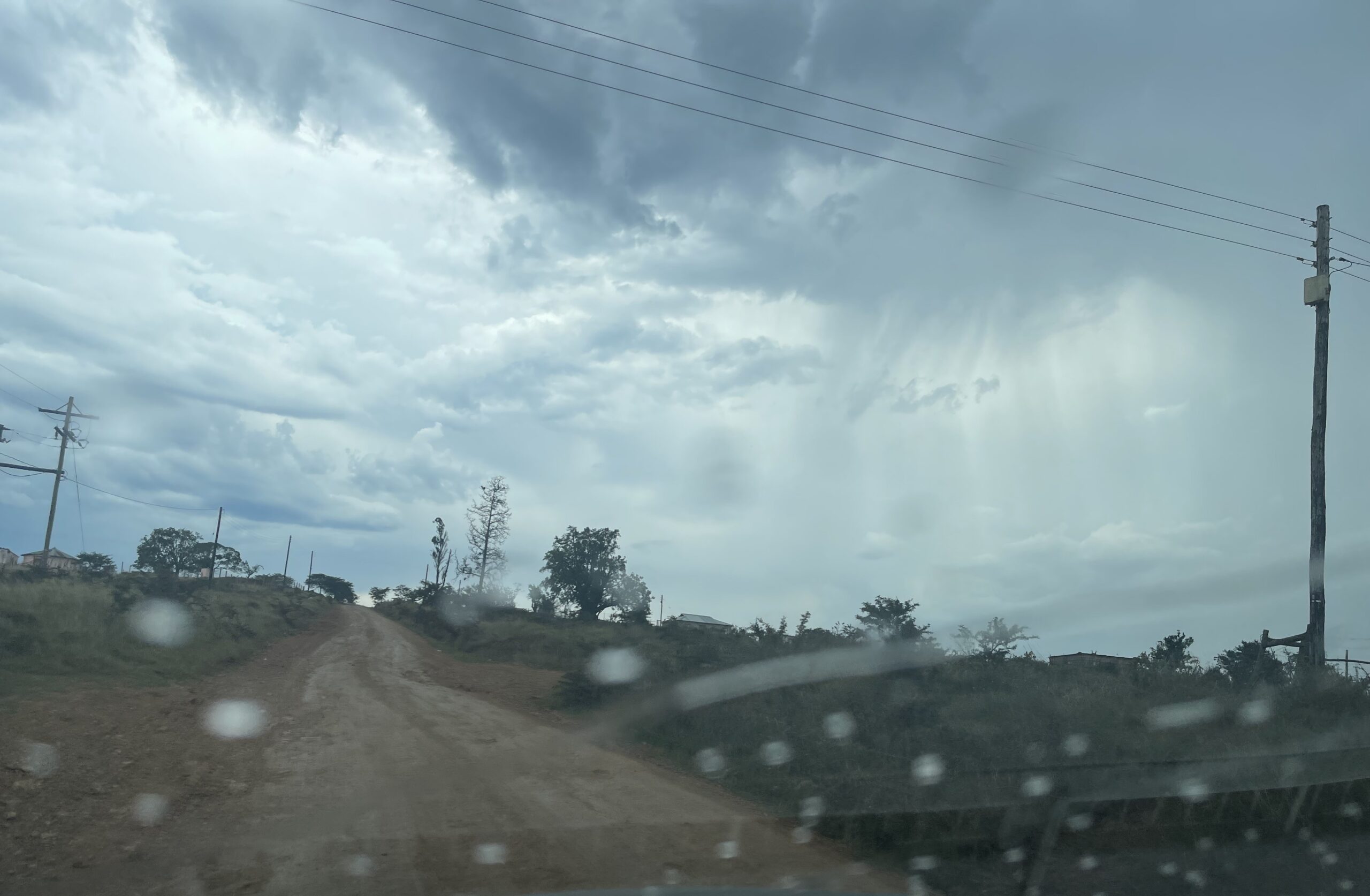

First we went trough road works again, traveling north east from Qonce along R63 and then turned left onto the poorly maintained sand road passing through Wiesbaden where Johann Michael Clur had his farm. This is now a small rural Xhosa town. Eventually we turned right onto a better gravel road leading to Frankfort. Once again we had to deal with livestock on the roads. From the moment we started our expedition to Frankfort the weather began to change, it became cooler and the sky gloomy. Over the Frankfort hill to the left we saw several vertical lightening bolts and it started to drizzle as we drove through Wiesbaden. When we reached the sign pointing to the graves it started raining so hard that we had to wait a while in the car. All was quiet, there was not a soul to be seen. The last 100 or so meters to the graves was impassable with the car, and as it was all too far for my mother to walk, we left her locked in the car for safety, armed with the codeword “banana”, a car hooter, and the possibility to feint calling for near by back-up troops as August Carl Clur did many years before!


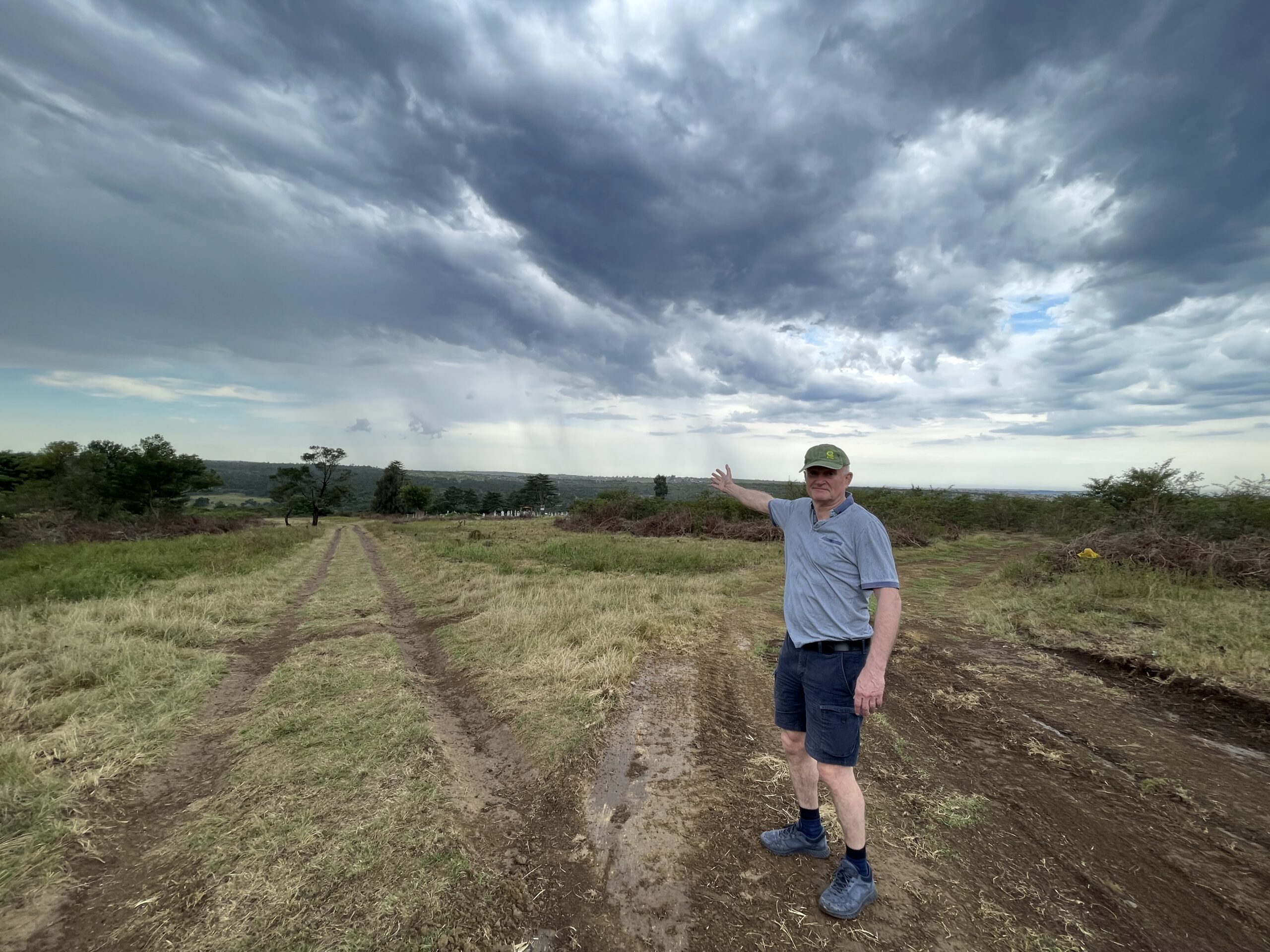

The sky was dramatic and it was fresh and cool now after the rain, as we walked to the cemetery. I was very pleasantly surprised by how good it all looked. Someone had been attending to it, it looked better than in the picture from 2021 on the graves-at-eggsa.org site. The arch at the entrance was painted and inscribed with “Selig sind die Toten die in den Herrn sterben, denn sie Ruhen von ihrer Arbeit.” – “Blessed are the dead who die in the Lord, for they rest from their work”. There were even pink flowers growing among the graves. I walked through the cemetery looking for Clurs and Pucherts, tripping every now and then on a tree stump and grazing my legs on the thorn bushes that grew between the graves. As I walked the lightening flashes continued to light up the sky in the distance periodically, usually in duplicate, followed by long, rumbling thunder. I could also hear the music playing in a nearby Shebeen. The rhythmic beat was surprisingly acceptable and soothing in this austere environment. I started at the top, Wilfried went further down the hill. Not all the texts and names were legible and many tombstones had fallen over. I only found one Puchert – Bertha Buss (nee Puchert – 1885-1915), but subsequently have found out that Anna Puchert (1904-1905) and Lydia Puchert (nee Berndt- 1896-1940) are also there. (See also Carl Georg Puchert – 1834-1914 , Marie Wilhelmine Werbelow – 1833-1923 and In search of Carl and Wilhelmine)
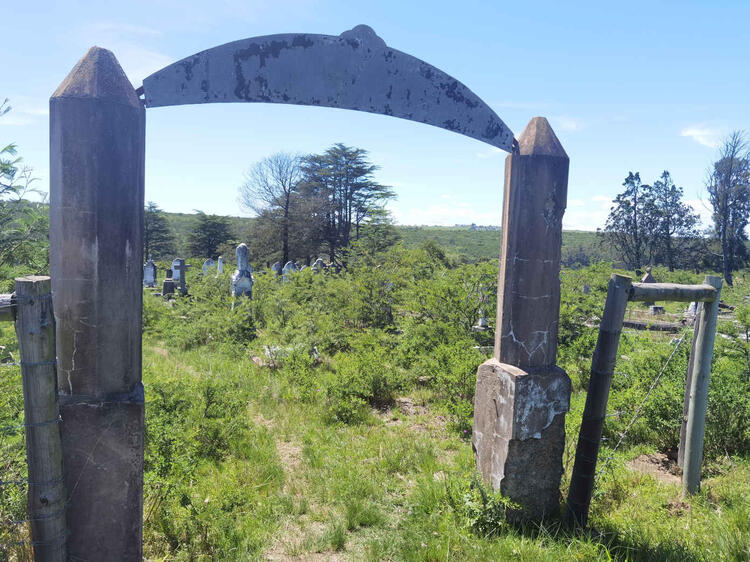
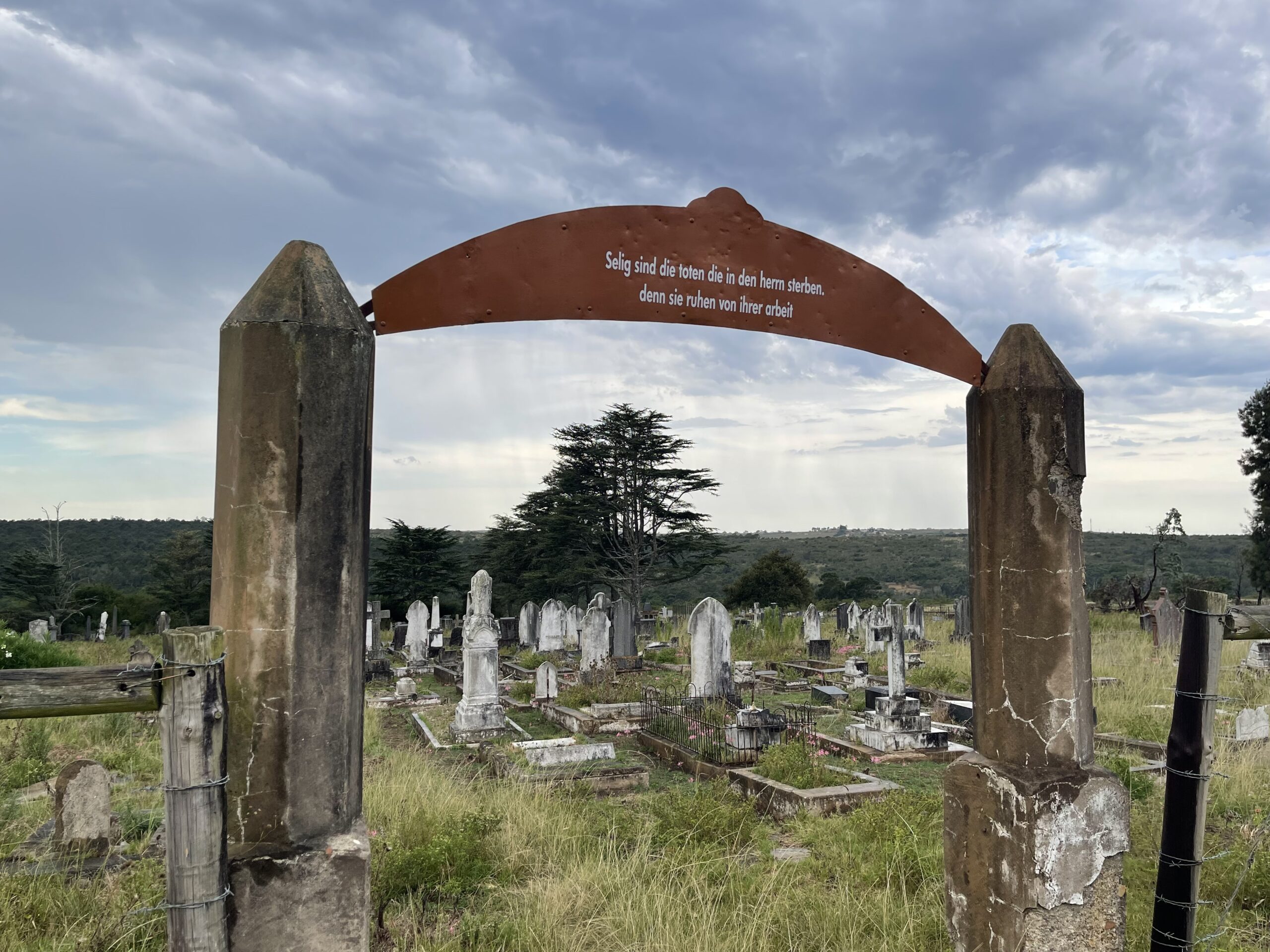

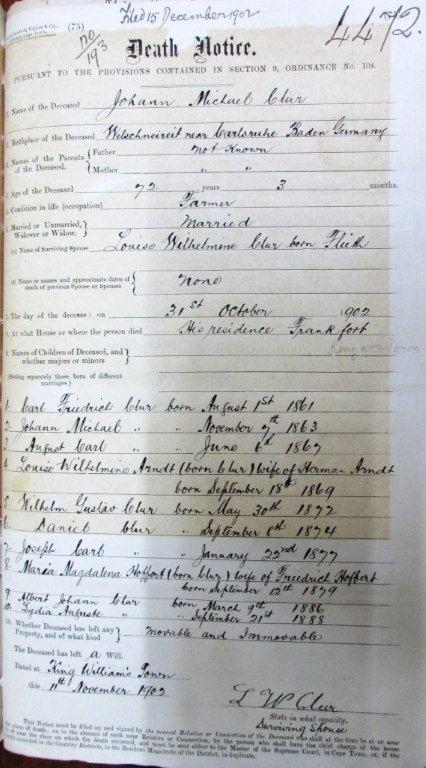
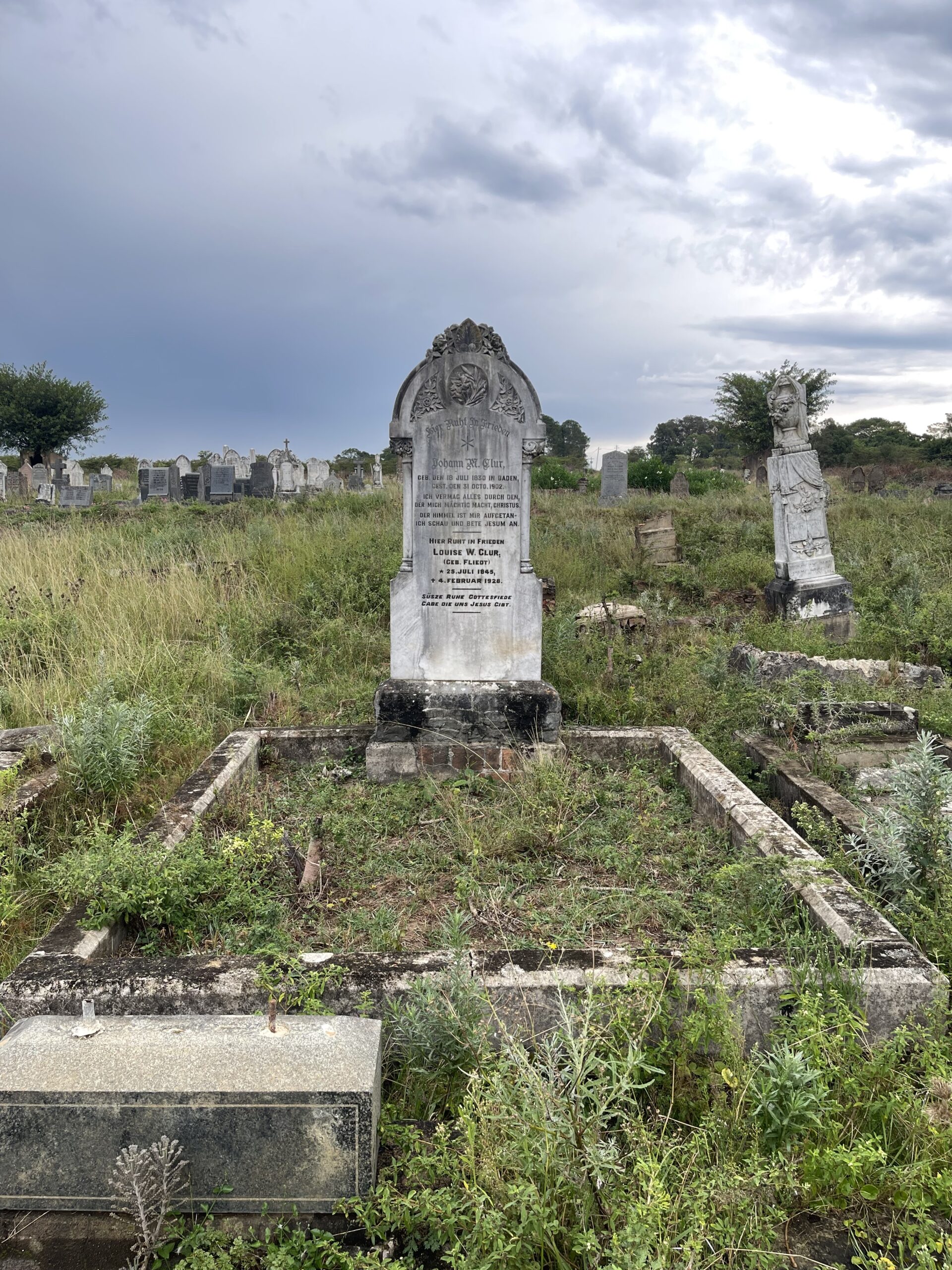
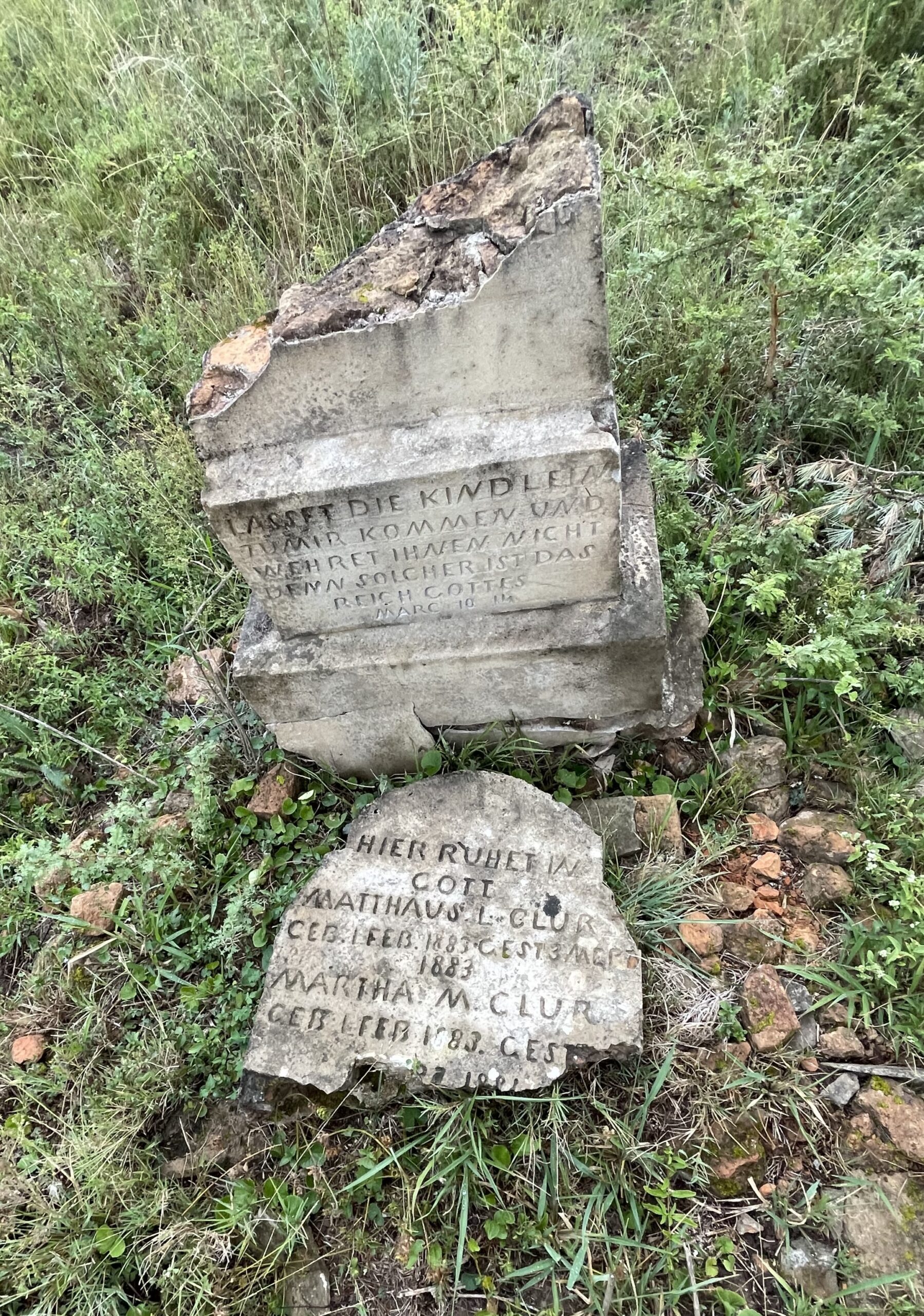
When looking up the German cemetery on the Genealogoical Society of South Africa (Search eGGSA Gravestone Photograph Collection (graves-at-eggsa.org)), I discovered that we had missed two children of Johann and Louise:-
1) Gottfried G.M. Clur (12th March 1885 – D 80 ME 1885) – He also died as a baby and this means that Johann Michael and Louise Wilhelmine had 13 and not 12 children. The inscription on Gottfried’s grave says something like: “Aber Jesus sprach Laset die Kleindlein und wart ihd n nicht zumierzu kommen en iieniert das Himmelreich. Mat 19.14” – “But Jesus said that he left the little ones and waited for them to come to the kingdom of heaven. Mathew 19.14”.
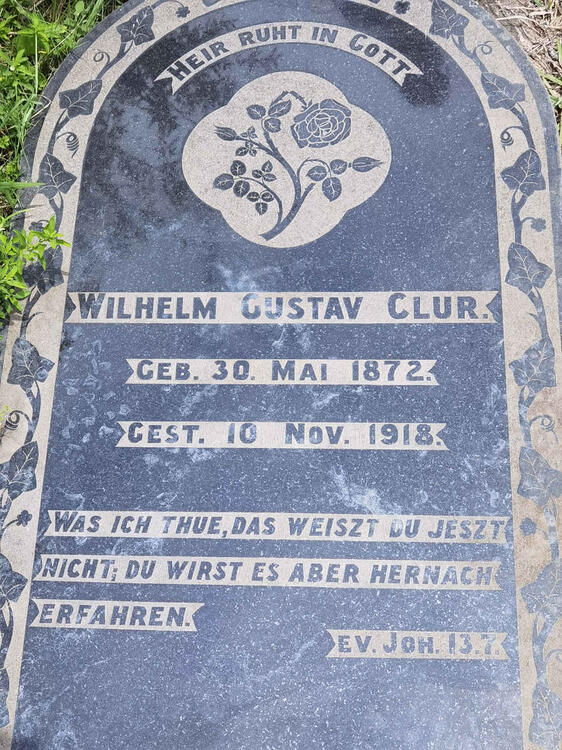
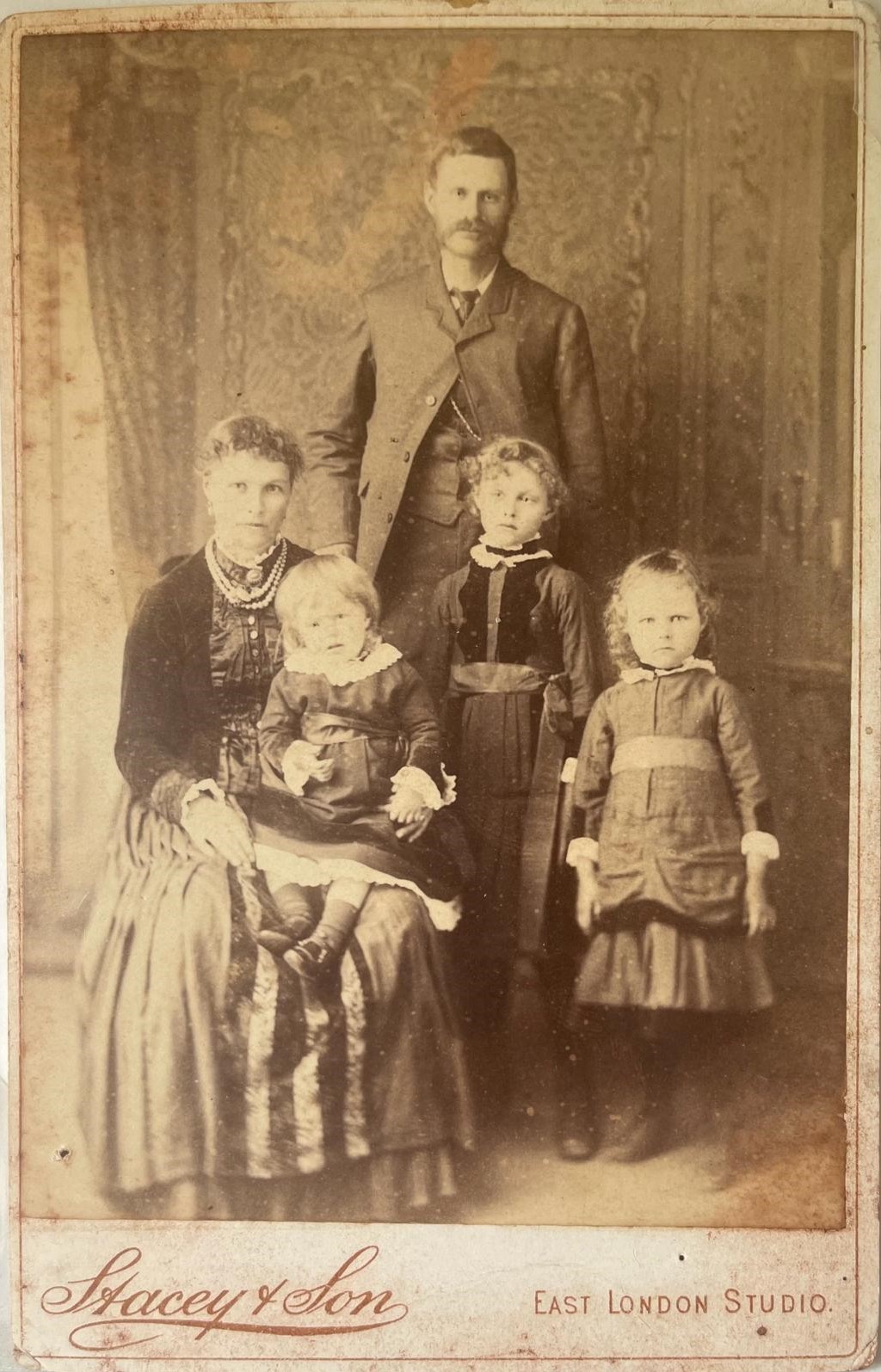
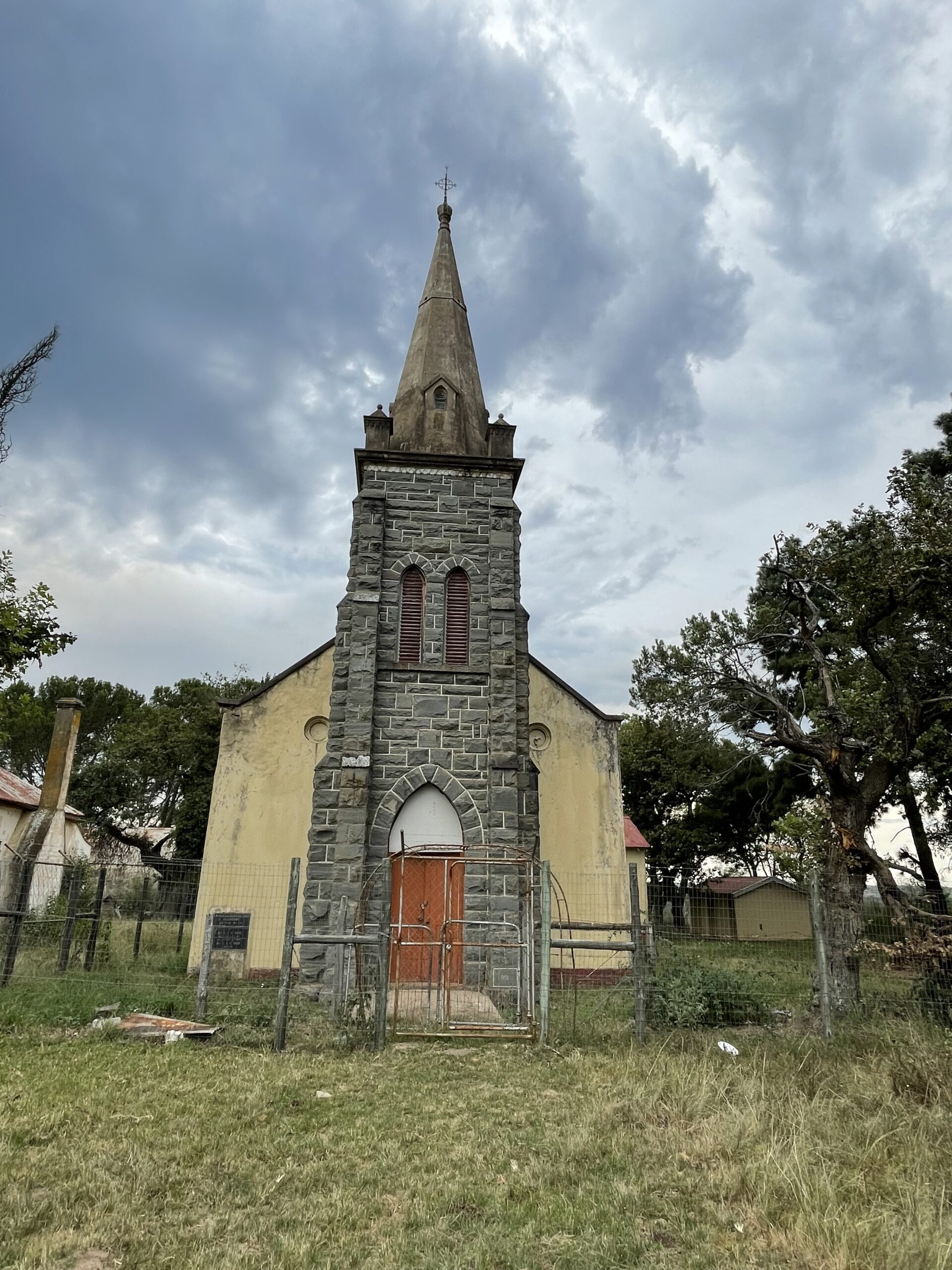
Wilfried found the first Clur, Maria Magdalena Clur. I thought at first that this was Johann Michael Clur’s, 8th child (12 September (or 11th September according to the Bethany Emmanuel Baptist Church database of the Amathole Museum), 1879 – ?), who married Friedrich Hof(f)a(er)t. However, this tombstone said that her birthdate was the 14th April 1878 and that she was born Hofat. Although I must say it was difficult to differentiate the B of GEB (geboren) from the S of GES (gestorben). Maria died on the 11th May 1959. I then realized that this was Maria Magdalena Hofat who married Wilhelm Gustav Clur (30th May 1872 – 10th November 1918). So a brother and sister Clur married a brother and sister Hofat and both girls were called Maria Magdalena! Maria Magdalena Hofat’s parents where Johann Wilhelm Friedrich Hofat and Emilie Henriette Antonie Krämer. The inscription on her tombstone says: “Ich habe eine guten Kampf gekampft; Ich habe den Lauf vollendet; Ich habe Glauben gehalten.” – “I’ve fought a good fight; I’ve finished the run; I have held the faith.”
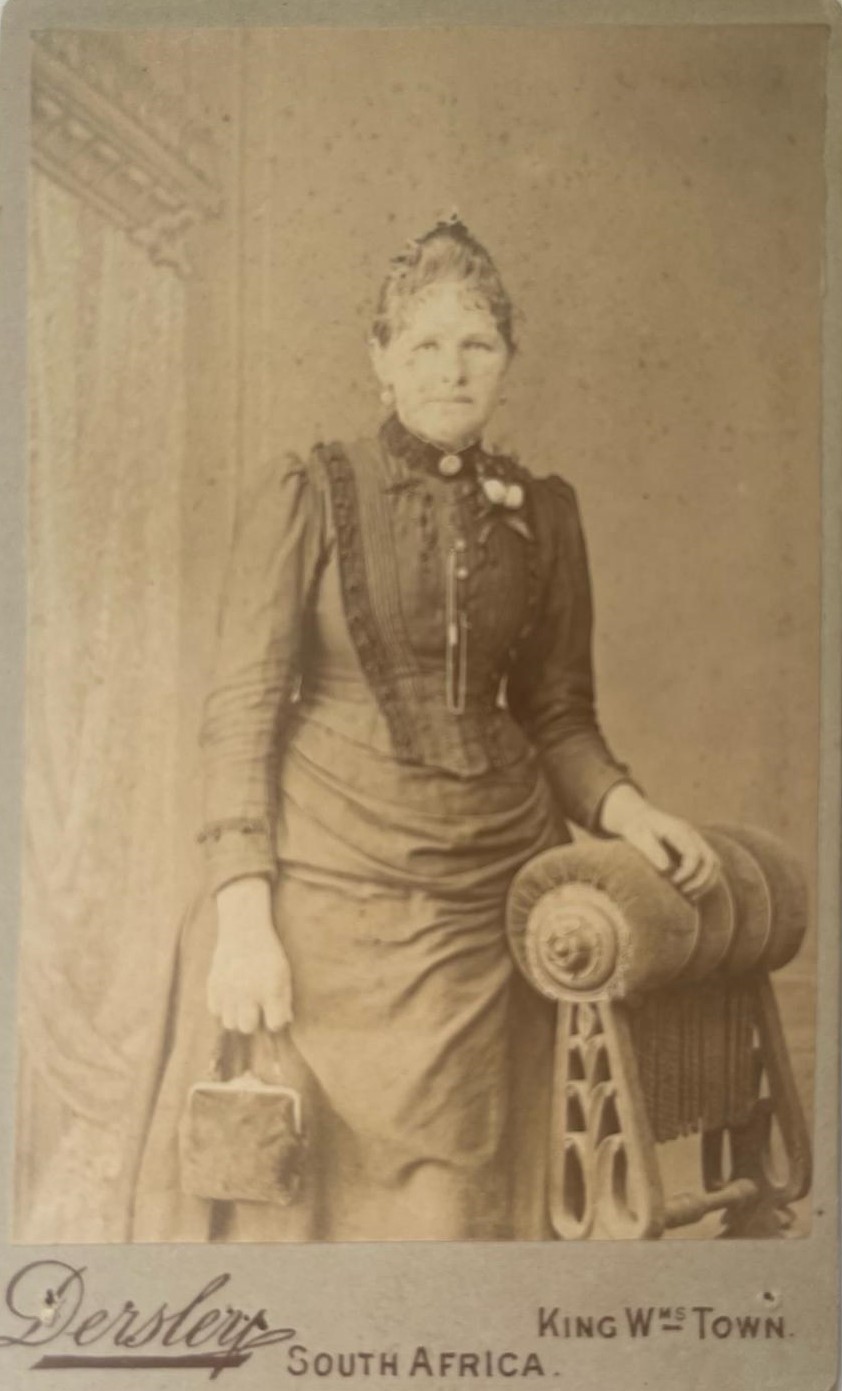
The Clurs are quite close together, and soon after Magdalena, I found the impressive tombstone of Johann M. Clur and his wife Louise W. Clur (25 July 1845-4 February 1928). It says that Johann was born on the 18th July 1830 in Baden, and died on the 31st of October 1902. The inscription says: “Ich vermag alles durch den, der mich mächtig macht, Christus. Der Himmel ist mir aufgetan – Ich schau und bete Jesum an.” – “I can do everything through Christ, who makes me mighty. Heaven has been opened to me – I see and worship Jesus.” The inscription below Louise says “Süsze Ruhe Gottesfriede, gabe die uns Jesus gibt” – “God’s sweet peaceful rest, the gift that Jesus gives us”
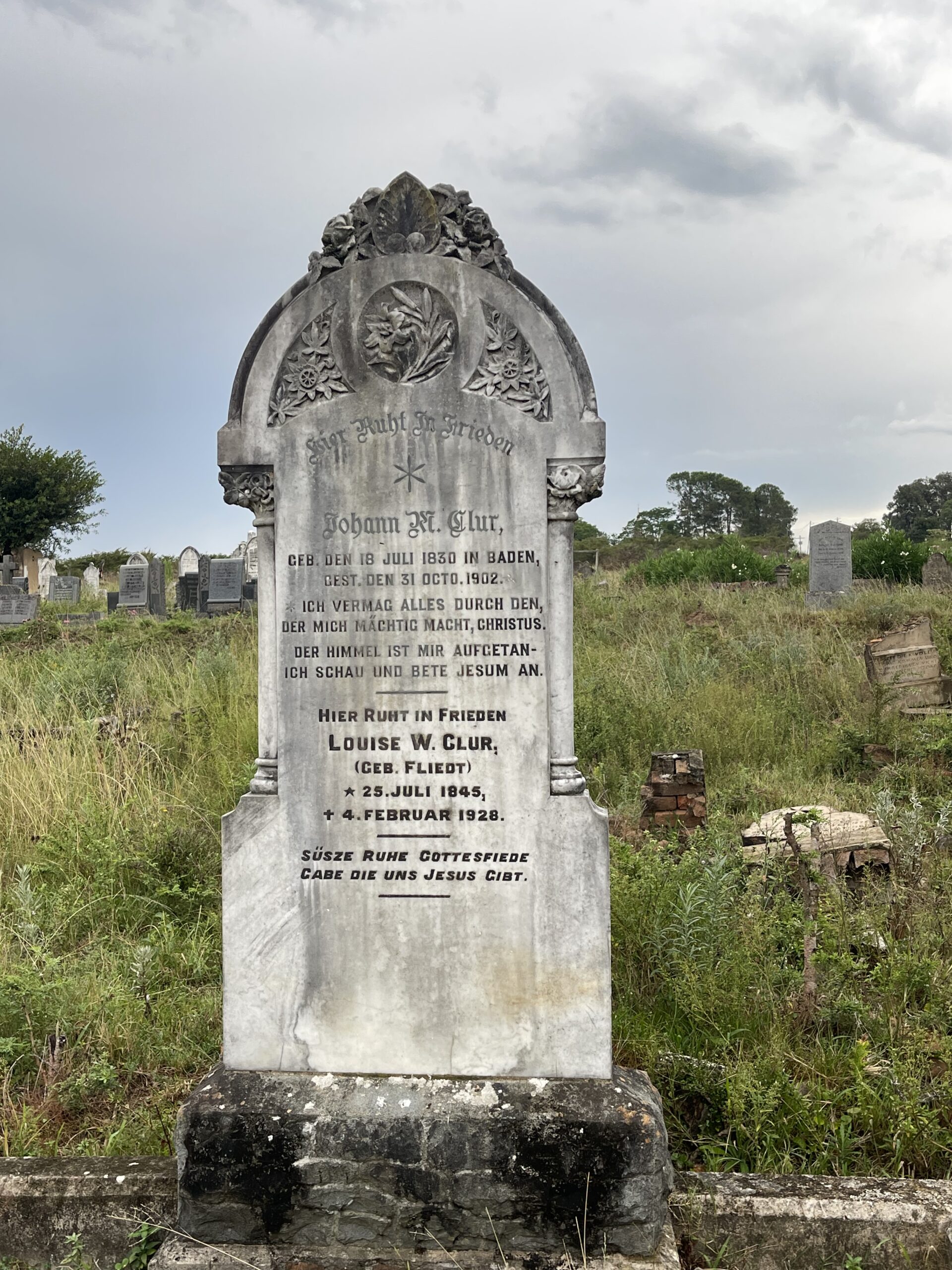
I stood at the foot of Johann and Louise’s grave looking up the mountain for some time, breathing slowly, taking it all in. These pioneers contributed to the beginning of me. Their strength and fortitude, become my inheritance.
So then where were the twins? “They must be close to their mother,” Wilfried said. I laughed, but sure enough, there they were, to the right of, and a bit higher than their parents, when looking up the hill. Wilfried found them by being drawn to the inscription on their broken tombstone. “Lasset die Kindlein zu mir kommen und wehret ihnen nicht denn solcher ist das Reich Gottes – Marc 10 11” – “Let the little children come to me, and do not reject them, for such is the kingdom of God – Mark 10:11”. Matthaus L. and Martha M. Clur were born on the 1st February 1883. Matthaus died on the 3rd March 1883 and Martha on the 21st March 1884.
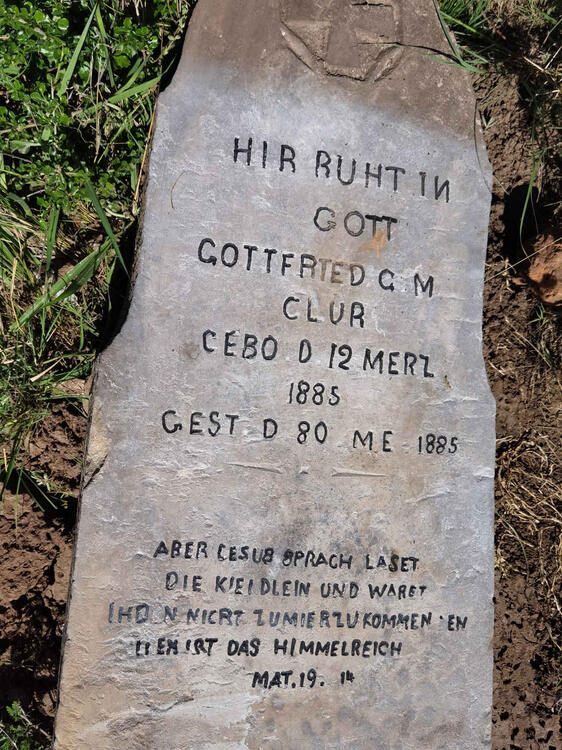
2) Wilhelm Gustav Clur (30th May 1872 – 10th November 1918) is also in the graveyard. His inscription says “Was ich thue, das weiszt du Jeszt nicht, du wirst es aber hernach erfahren. EV. Joh 13.7” – “You don’t know what I’m doing, but you’ll know it later. EV. John 13:7”. The Bethany Emmanuel Baptist Church database tells us that he was born in Wiesbaden and baptized on the 23rd August 1891 by Rev. Schmidt. The testimony of Gertie Wulff tells us that he died of Spanish ‘flu.
It was now getting rather late and we still had to make our way back to Makhanda, formerly Grahamstown, for the night. Wilfried went back to the car to check on my mother while I lingered, just a little longer, looking down the hill. Scattered between the German settler graves the occasional Xhosa graves can now be seen and on the right side of the extended cemetery new Xhosa graves have been laid. So, even though they were enemies in the past, here the German Settlers and the Xhosa locals lie together in peace with God.
When I left the cemetery I engaged with two young Xhosa boys who smiled and waved at me. Then two big barking ridgeback-cross dogs, one a light tan and the other black and tan came bounding down the hill towards me. Wilfried had been taken off guard thinking at first that the lighter one was a lion! I was calm and spoke to them while the darker one licked my hand. The dogs belonged to the caretaker living at the old Frankfort Lutheran Church. The church is now the Frankfort branch of the E.L. United Congregational Church of South Africa. He said that his brother was the person who had been tending the Cemetery. The Church was somewhat run down, fenced in, and padlocked. I wondered when it was last used.
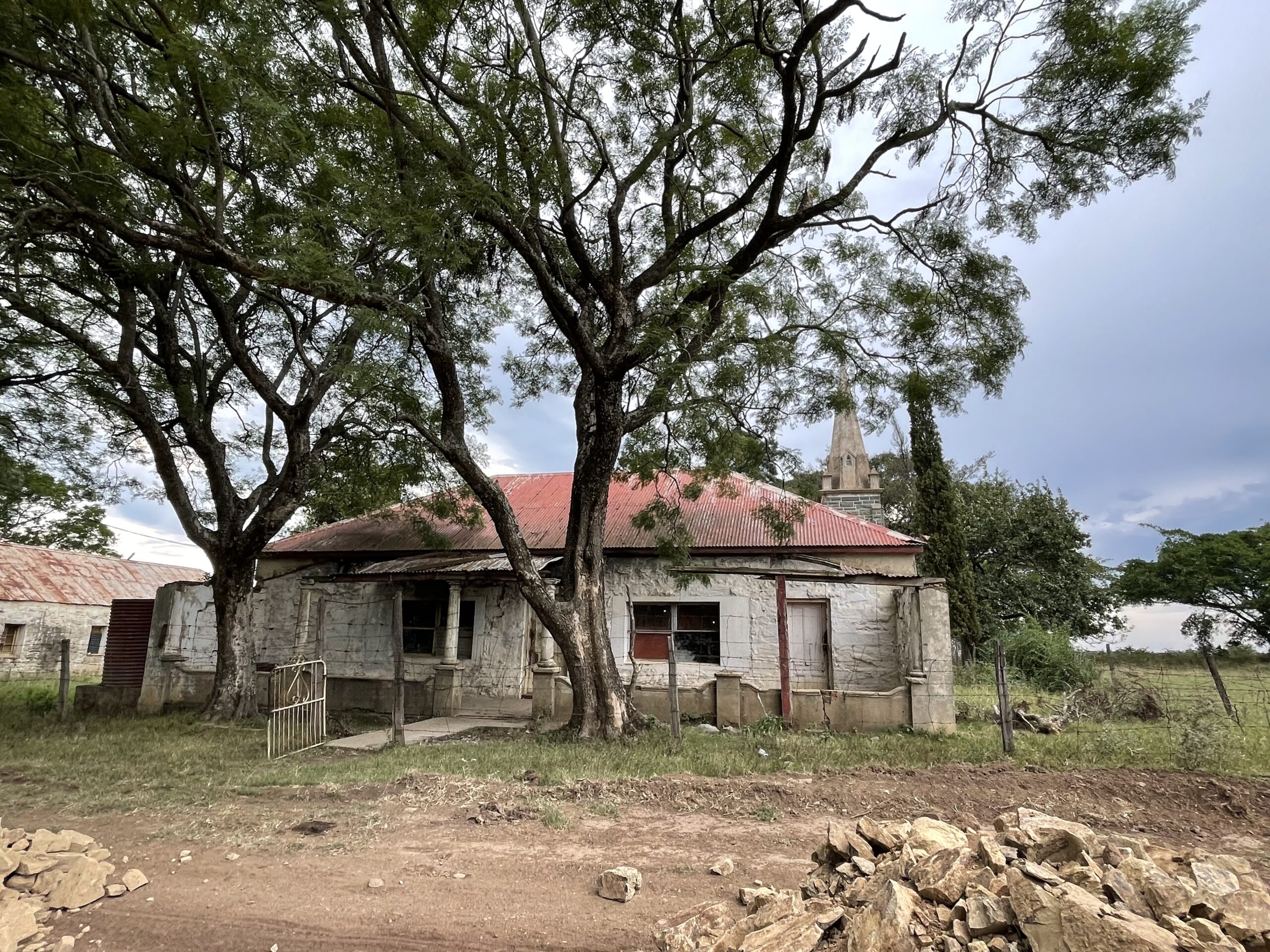
We left Frankfort and made off for Makhanda with, we thought enough time to make it to our B and B before the reception closed. However, once on the N2 again, somewhere between Peddie and Makhanda we had to stop behind a very long line of cars. We just happened to stop in front of a road sign saying “BLASTING .. 15h00, approximate delay of two hours”. At first I read “BELASTING” and wondered why that word had been used for a traffic obstruction. Although the word ‘belasting’ (taxing) was actually appropriate, I laughed when I realized my reading error. I also wondered why, there was not a sign earlier, at Peddie for instance, warning us of the coming traffic obstruction when we could still have chosen another route. It was now around 17h00 and we could then expect to move again half an hour later or so. I had needed to pee for ages but refused to squat next to the car with onlookers all around.
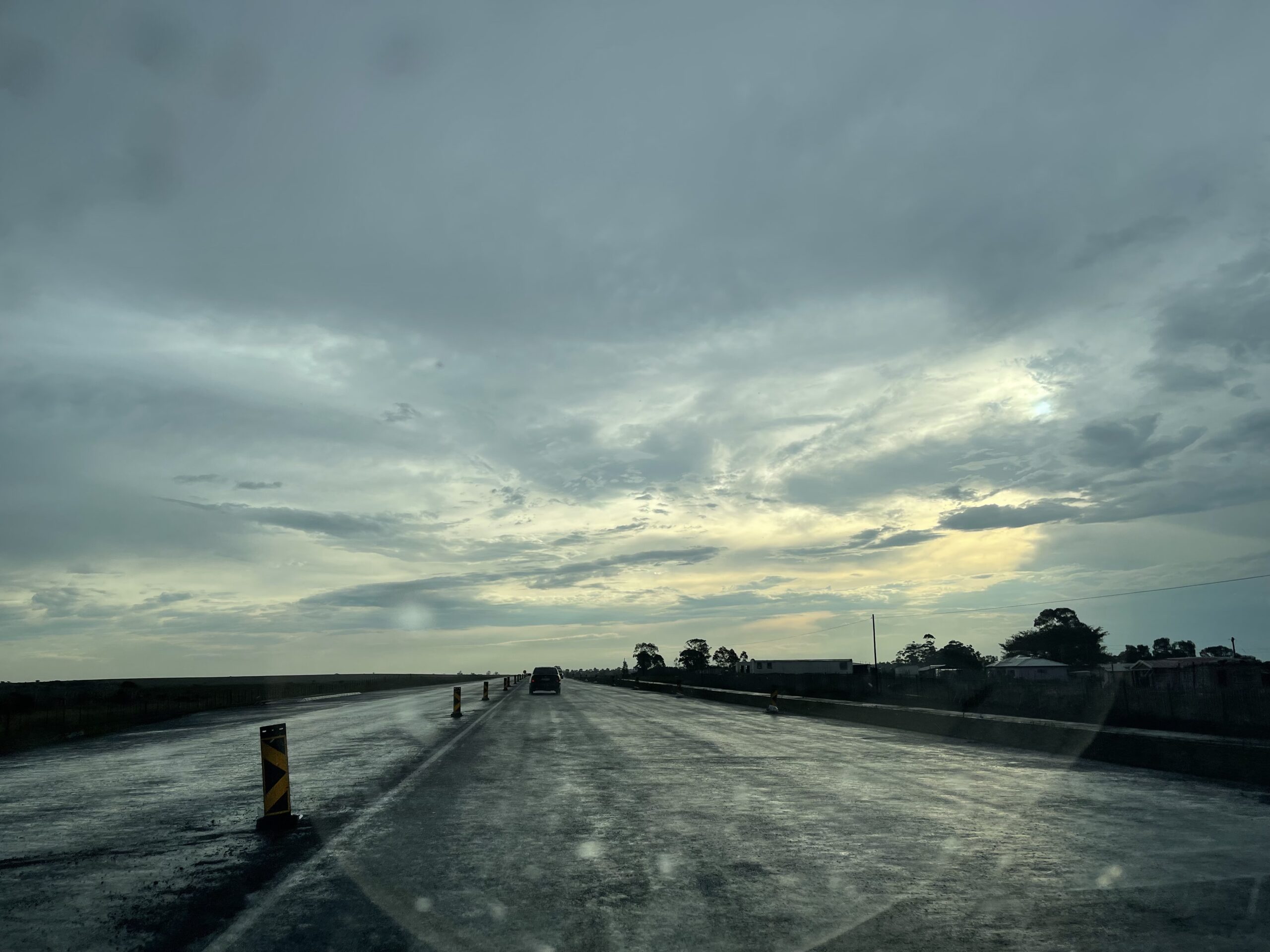

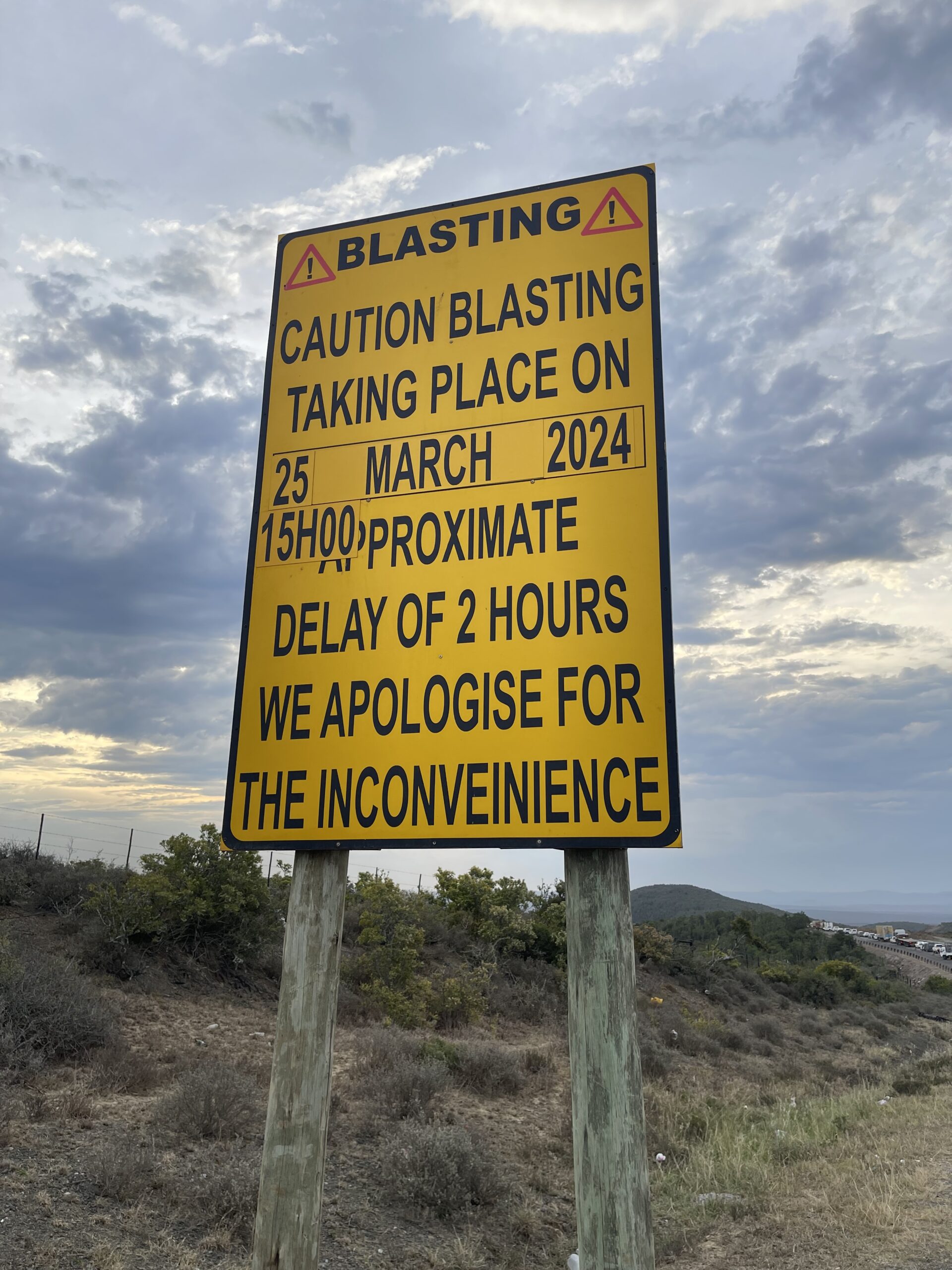
By 19h00 we were still sitting there. It was dark and I still needed to pee. We were starving, Wilfried’s mobile phone battery (with our navigation) was almost empty and we started envisioning a night in the car. When a roadworker walked past a bit later I asked him what was happening. “You know”, he said, “they were blasting and the whole mountain fall on the road. It is hard work moving those stones.” At 19h24 the kilometers of cars started to creep forwards. People were tired and impatient by now. Driving was difficult in the dark and the road was narrow. People started taking risks, illegally overtaking, and driving in the wrong direction. The numberplate of one of these idiots said, quite appropriately, “JRK — EC” (i.e. jerk). Needless to say, by the time we reached Makhanda it was too late to find anything decent to eat – it was a Monday night after all. So we ended up buying stale chips at a late night cafe. When driving to our B and B we came across several unescorted donkeys and a cow crossing Sommerset Road very correctly at the stop street! I went to bed thinking, “Today, I was in Africa”.
26th March 2024: The Kidwell Bible and the Jamestown Barkers.
After a full English breakfast at the comfortable Fiddlewood Guest House, we set off to the Albany Museum of Rhodes University. We entered the natural history section first by mistake. After a short discussion about the similarities between an Emu and a Phorusrhacos, we were quickly redirected to the next door History building. Climbing the impressive staircase at the main entrance of the History building was no mean task for my 90,5 year old mother. When we entered the foyer it seemed abandoned. In a room next door painters were busy, and with their help we were able to make contact with the Curator, Gcobisa S. Zomelele. She was very welcoming and when I told her that we had come to see the Kidwell Bible, she went out of her way to make it possible, even though we did not have an appointment.
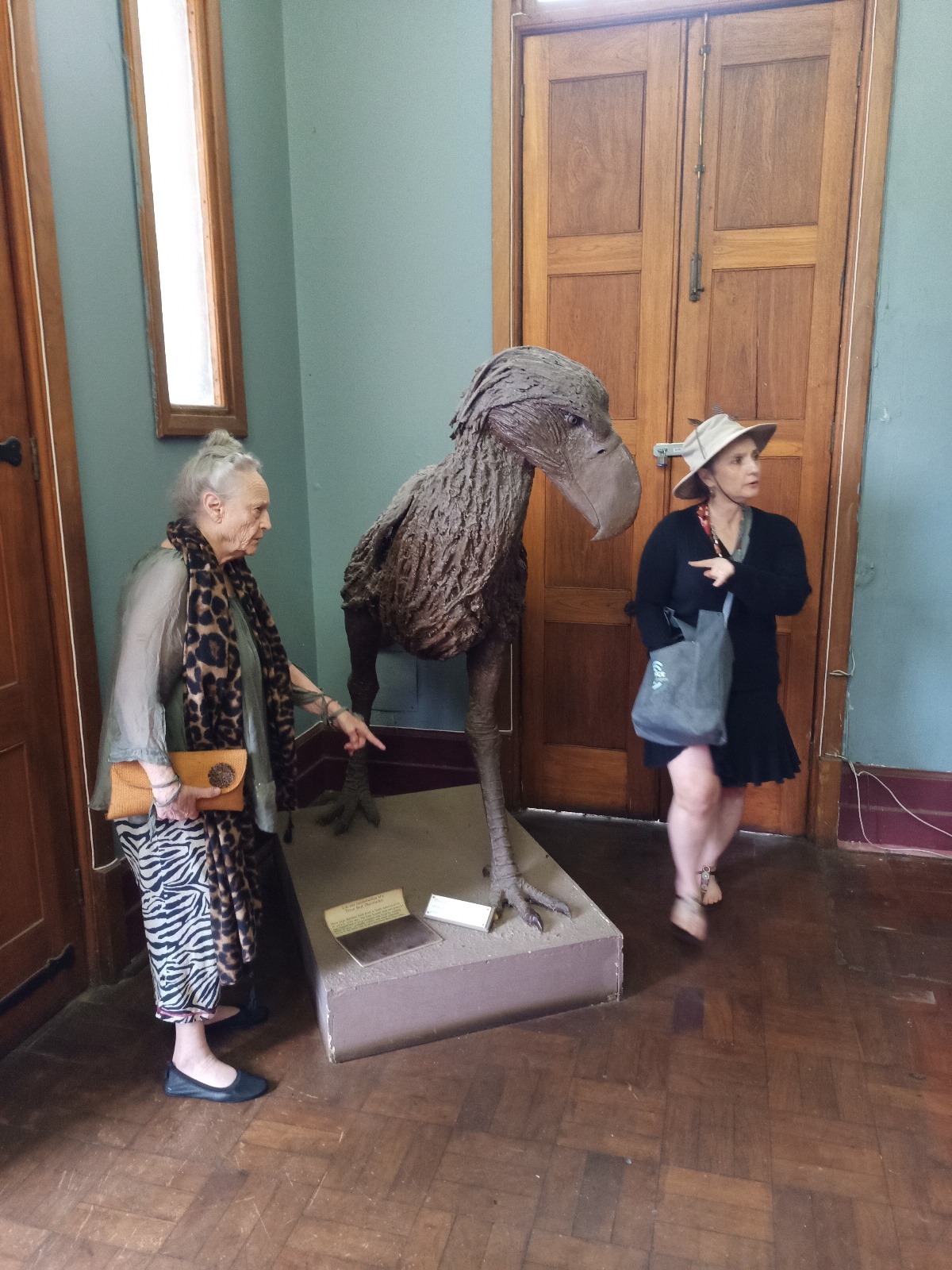
Featuring my mother, Denise Clur, (Nee Barker), a prehistoric Phorusrhacos and myself. Copyright: © wvisser
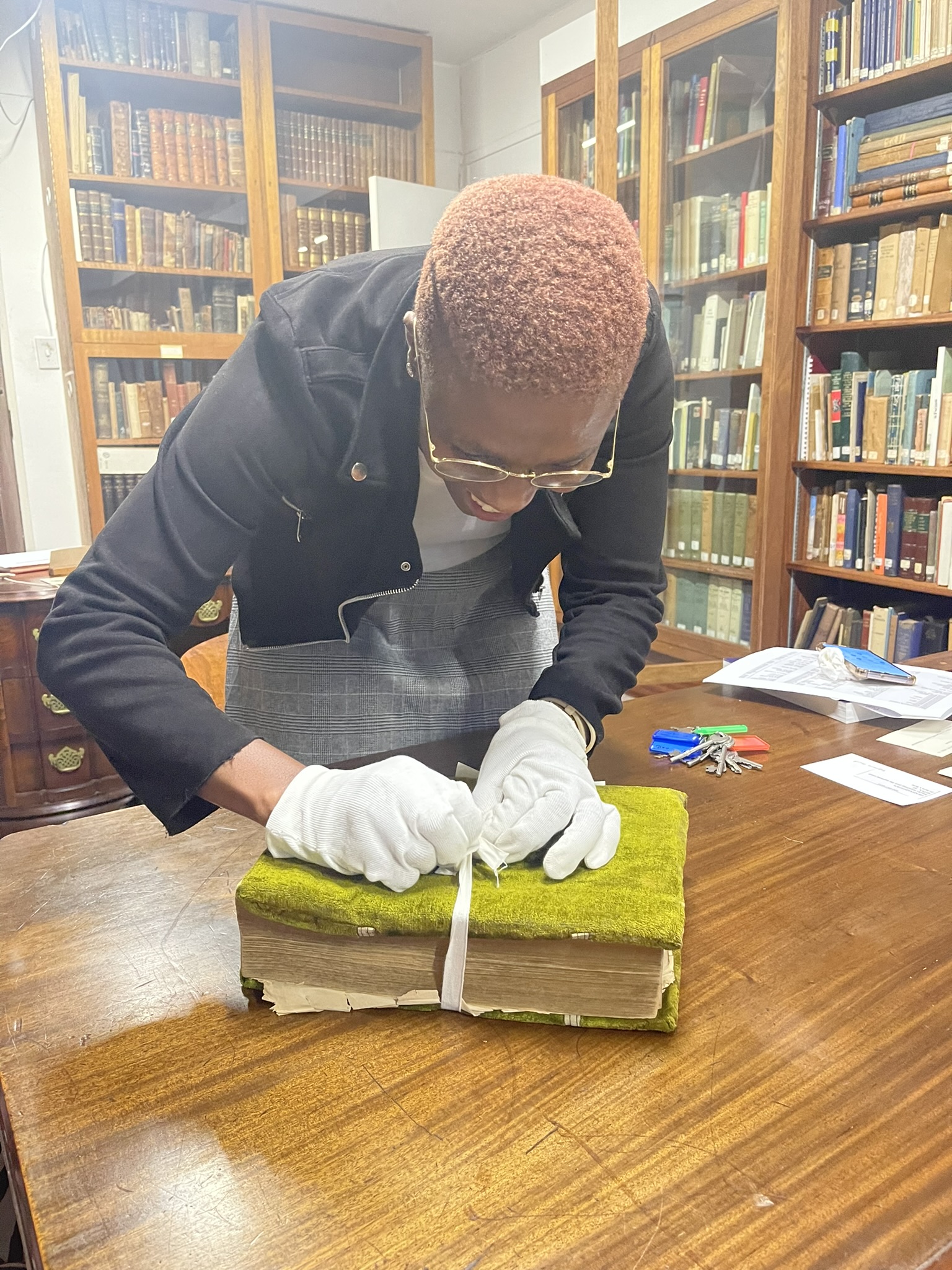
The Kidwell Bible was given to Alexander James Kidwell by his mother. It gave him strength over the years. He was the grandson of Alexander Kidwell and Phebe Tubb, both 1820 British settlers. Alexander James’ grandfather was the first person to free a slave in South Africa. Jane Wills Orchard (19th February 1848 – 16th October 1922) married Alexander J. Kidwell in 1867. My great, great, grandmother **Fanny Kingdom Cusens (nee Orchard) (circa 1849 – 7th January 1897) was Jane Wills Orchard’s sister. Alexander Kidwell and my great grandfather, **William Joseph Barker (1875-1948), were friends. Even though Alexander J. has been recognized as the “Father of Jamestown”, both he and my great grandfather played important roles in the development of Jamestown. William Joseph Barker came to South Africa after his fiancee died of tuberculosis in England. He too was not well and it was thought that the South African climate would do him good. He was a teacher and later an inspector of schools. He got a position at the Bensonvale Native Training School for teachers in the Herschel District where he met my great grandmother **Beatrice Emily Jane Cusens (Trixie). He married her on the 7 April, 1903. He had become the Principal of the Jamestown Public School by then. When he arrived it was only a Primary School, but when he left Jamestown at the end of 1918 it was a High School and in addition he was also training Pupil Teachers. He also, along with Kidwell, was a member of the Jamestown town guard during the Boer war (1899-1902). His letter describing his role in the Battle of Jamestown is now an historical document. (see also **Mary Ann Stears (1820 – 1903) and **George Adolphus Cusens (1819 – 1911) and **William Joseph Barker (1875-1948) and **Beatrice Emily Jane Cusens (1874-1957)

Alexander J. Kidwell was the Jamestown Special Justice of the Peace as well as a merchant and Methodist preacher. At the time of his retirement from Public Office he was honoured for his service to the community. William Joseph Barker was one of the signatories at the bottom of “a beautiful illuminated address” given at the time. The other signatories were Thomas Frederiek Le Roux, Edwin van Reenan Schlemmer and Walter Barlow. A copy of this address has been attached to the front of the Bible by Hannah May Kidwell (nee Gleeson), wife of Kidwell’s son Reginald Hilary Kidwell. Jamestown, Eastern Cape – Wikipedia, Miss Wagenaar’s book) “Jamestown 1874-1974”, 06 | KIDWELL Alexander James, died 1912 and Jane Wills ORCHARD, died 1922, married 1867 Fort Beaufort | The eGGSA Bible Collection | eGGSA.org

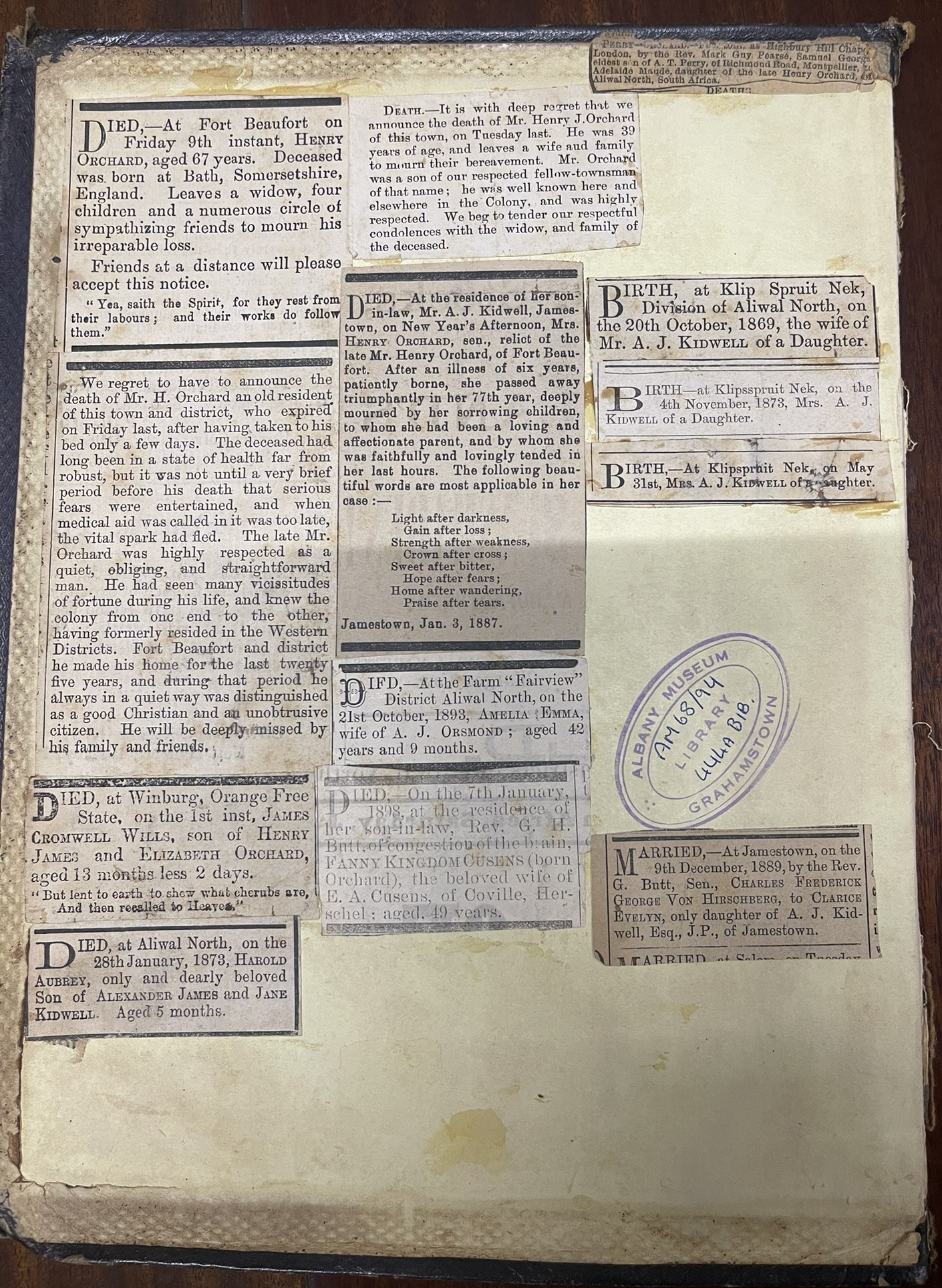
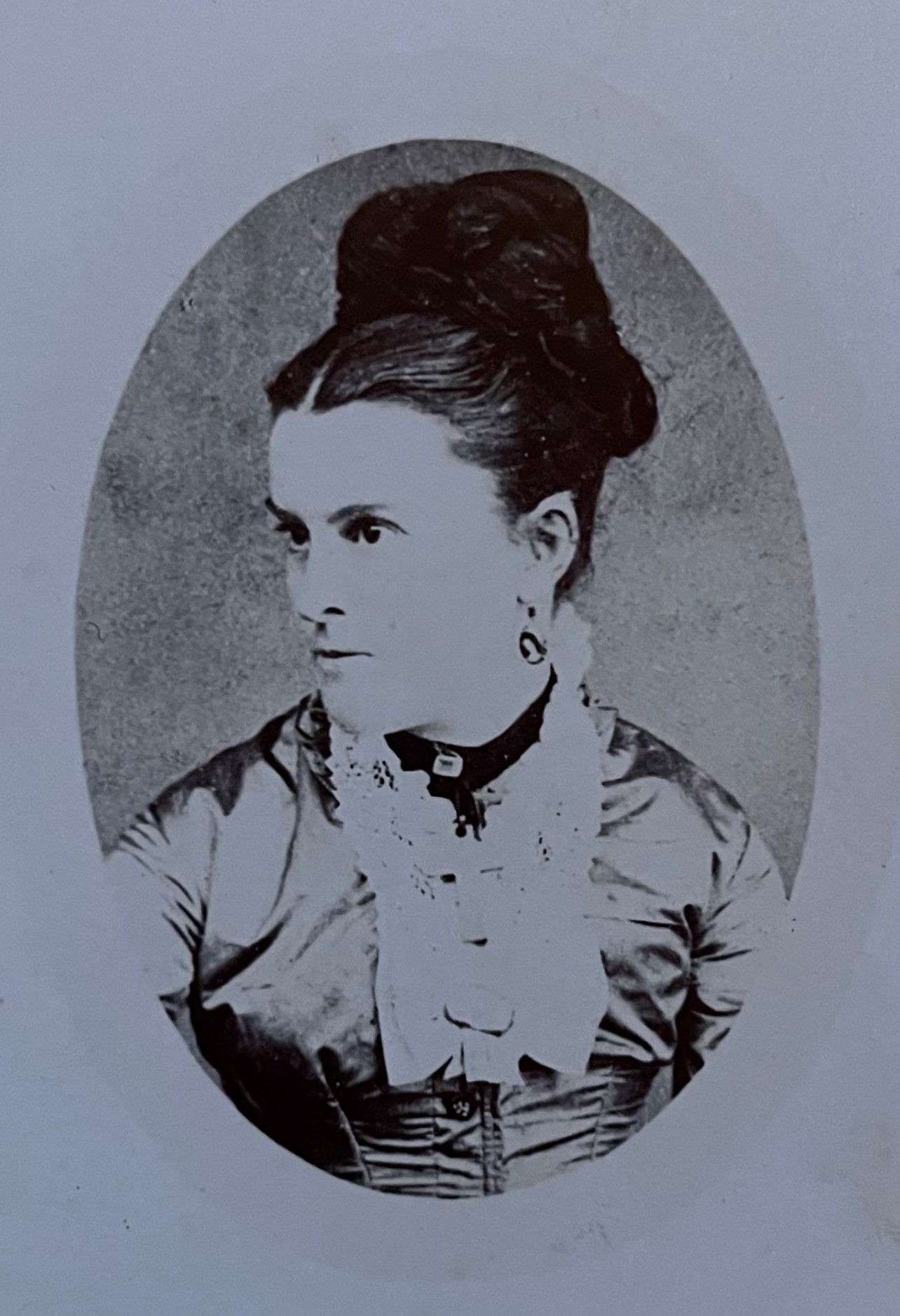



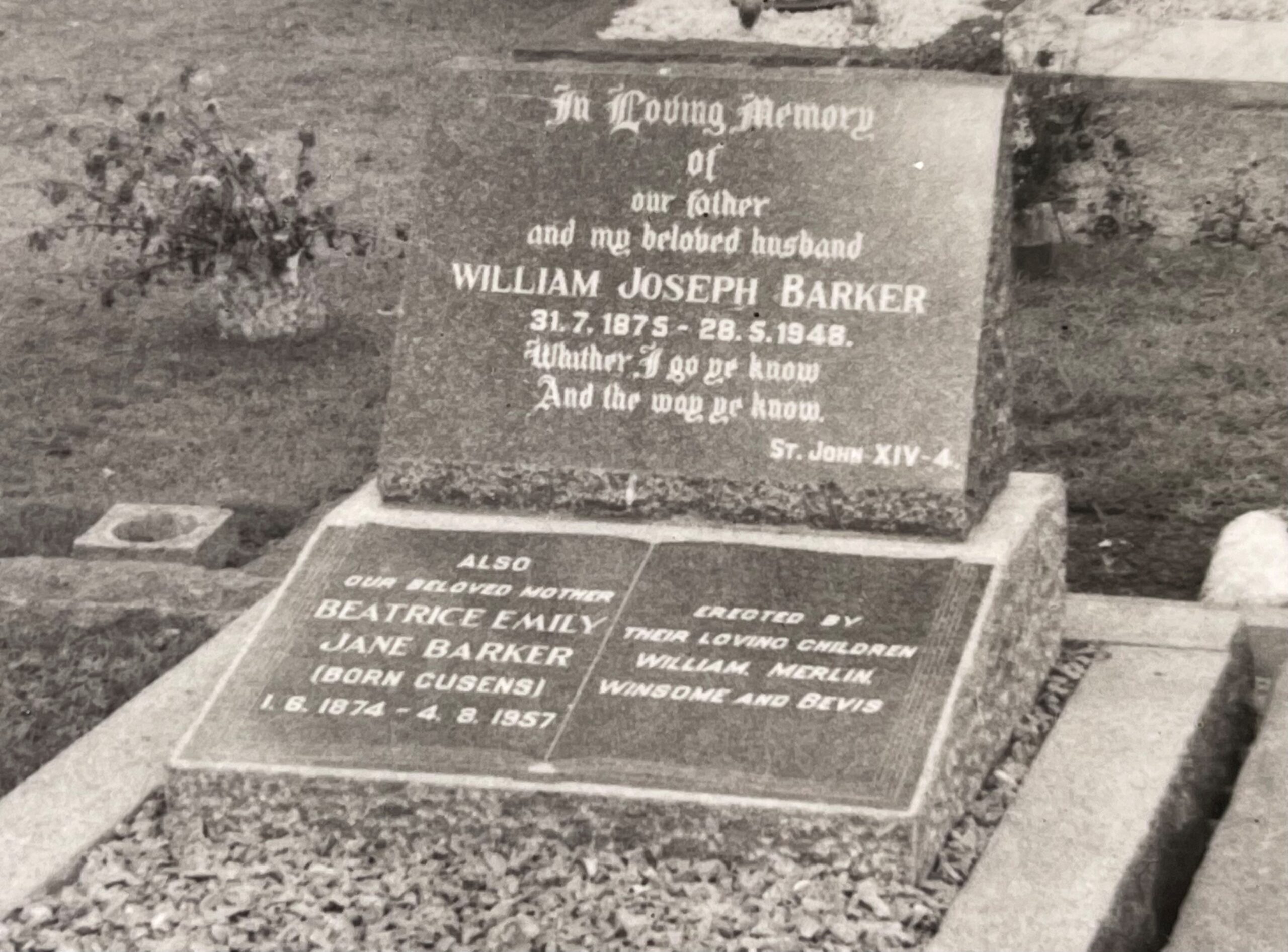
At the bottom of the third row of the inner side of the cover of the Bible, the death notice of Fanny Kingdom Cusens (nee Orchard) can be seen. She died young, aged 50, of heart problems on the 7th January 1898. The notice says she died in “the residence of her son-in-law Rev. J.H. Butt of congestion of the brain”. Rev Butt married Hilda May Cusens, Fanny’s daughter and sister of my great grandmother, Beatrice Emily Jane Cusens . When wandering through the German Cemetery the day before, I had also came across a Friedrich Butt (1820-1899), and wondered if they were family. However these Butts were from England. According to my mother, the Butt family later went to St. Ives where they set up a photographic studio.
One of Alexander Kidwell and Jane Wills Orchard’s 6 children, Clarice Evelyn, married Carl Friedrich Georg von Hirschberg (1862- 3rd October 1934). Carl was born in the King William’s Town area, near the farm of Johann Michael Clur. Carl was the son of Count Franz von Hirschberg (?-c1885) and Countess Adelheid von Lilienstein (12th October 1833-13th June 1912). Carl Friedrich Georg von Hirschberg “Junior” (1926-2017) was the grandson of Carl and Clarice. He was a diplomate and deputy-director-general in the South African foreign affairs department when he wrote the “good” version of the “Rubicon speech” that president P.W. Botha was supposed to deliver at the Natal congress of the National Party in 1985. Instead of delivering a speech with hope for the abolition of Apartheid and possible freedom of Nelson Mandela, P.W. changed the speech and a very different picture was sketched leading to world outrage. http://geni.com/people/Carl-Von-Hirschberg/6000000077332922073, https://www.timeslive.co.za/sunday-times/opinion-and-analysis/2017-06-17-obituary-carl-von-hirschberg-writer-of-rubicon-speech-pw-botha-failed-to-deliver/, Geni .com.
After we had looked at the Bible, we were assisted by an old Rhodes alumna who showed us the Kidwell files. She was very helpful and attentive. I am sorry that I have forgotten her name. She really perked up when she heard that my parents were both Rhodes alumni, and even more so when she heard that my mother was the only female in her physics and mathematics class. My father, Dennis Clur, got a MSc in chemistry and my mother, a BSc honours in mathematics and physics at Rhodes and much later in chemistry at the University of the Witwatersrand. My mother was charmed by the historian’s questions and interest. When she suggested getting in contact with the Rhodes old alumni office, my mom said “Oh, according to them I am deceased”. Besides the historian’s interest in the South African immigration programs, she appeared also to be especially interested in old alumnae. Stephanie Victor is also a Rhodes alumna. I noticed then that all my dealings with historians in the last few days had been with women. My parents met at Rhodes University. I also used to think that that was the first point of integration between my British and German ancestry. But I have now discovered that the connections go back much further.
We left Makhanda along the R67 and made our way past Bathurst and back to Port Alfred. I have travelled this road many times before. As we went, we reminisced about travelling from Johannesburg to the Kowie for the Christmas holidays. We would always leave in the very early hours of the morning, my mother would bundle us into the back seat with pillows and blankets and we would usually sleep until we reached Vereeniging (Emfuleni now). My mother always packed sandwiches and boiled eggs that we ate in the car so as not to loose time stopping unnecessarily. We hated the eggs that always had green rings around the yolks. I remember once stopping en route at Jamestown and looking around with my mom. In the main street of Jamestown the sandstone Kidwell Memorial Church can be seen which was named in his memory, as is the adjacent Kidwell Street. At the church there is a plaque listing the people who were responsible for its construction. My great grandfather William Joseph Barker is listed there. Before leaving Jamestown my mother sent my grandfather a telegram telling him to expect us soon.
By the time we got on the R67 we were always quite excited in the back of the car. The smell of the vegetation told us that we were near the sea and we used to play “the first to see the sea is a rotten egg”. This was rather appropriate, as some of the green ringed egg yolks were invariably squashed between the blankets and pillows by then. My father had a MG, and later a green Triumph when I was very young. My mother loved that Triumph. My father made a plank bench at the back where my brothers Alwin and Gavin would sit and I sat on the lap of whoever wasn’t driving. My brother vividly remembers nearly throwing up as my mother sped along the winding mountain passes leading to Bathurst in that green Triumph. My mother said in her defense that her driving was not nearly as scary as her mother Doris Barker’s on that same stretch of road!
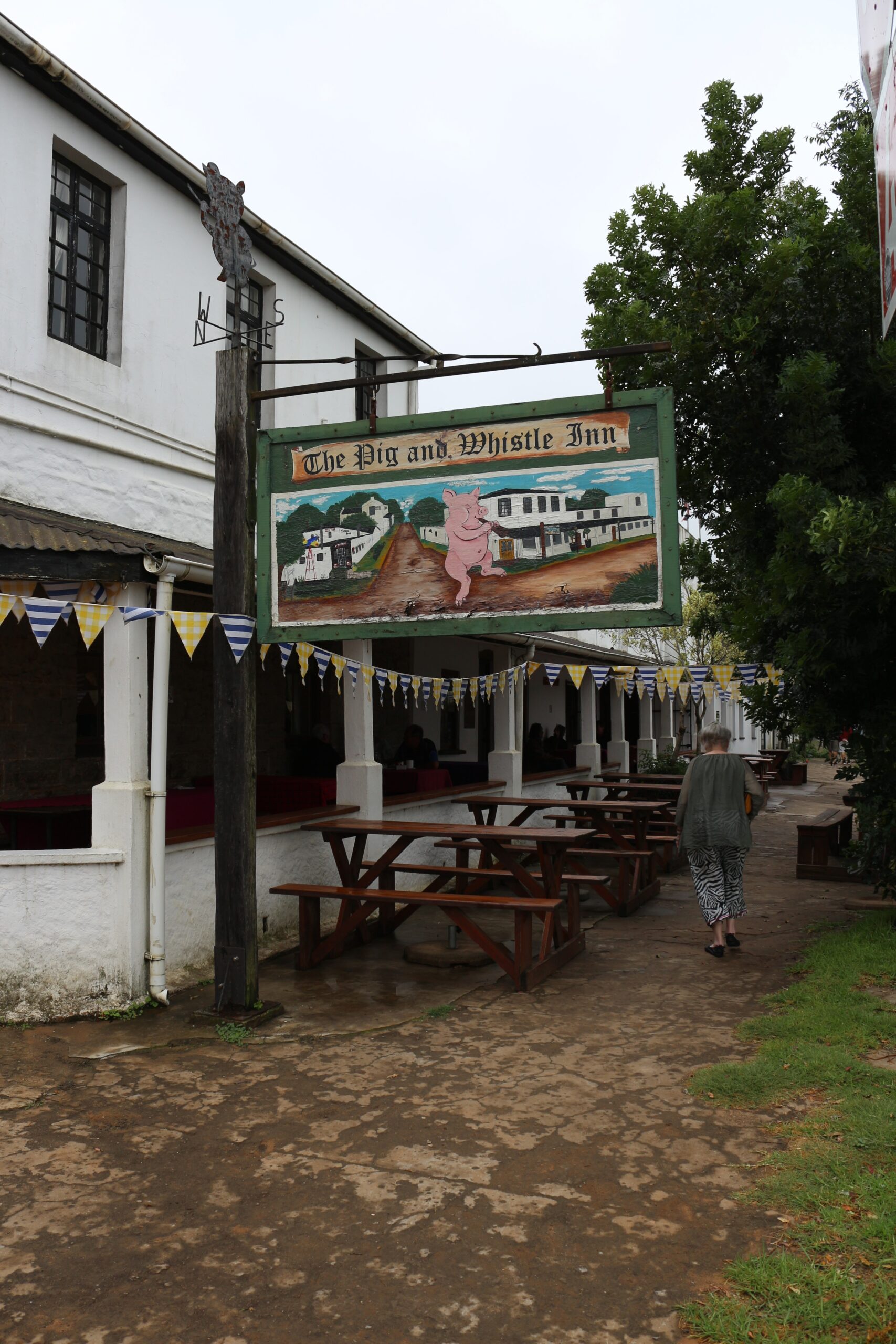
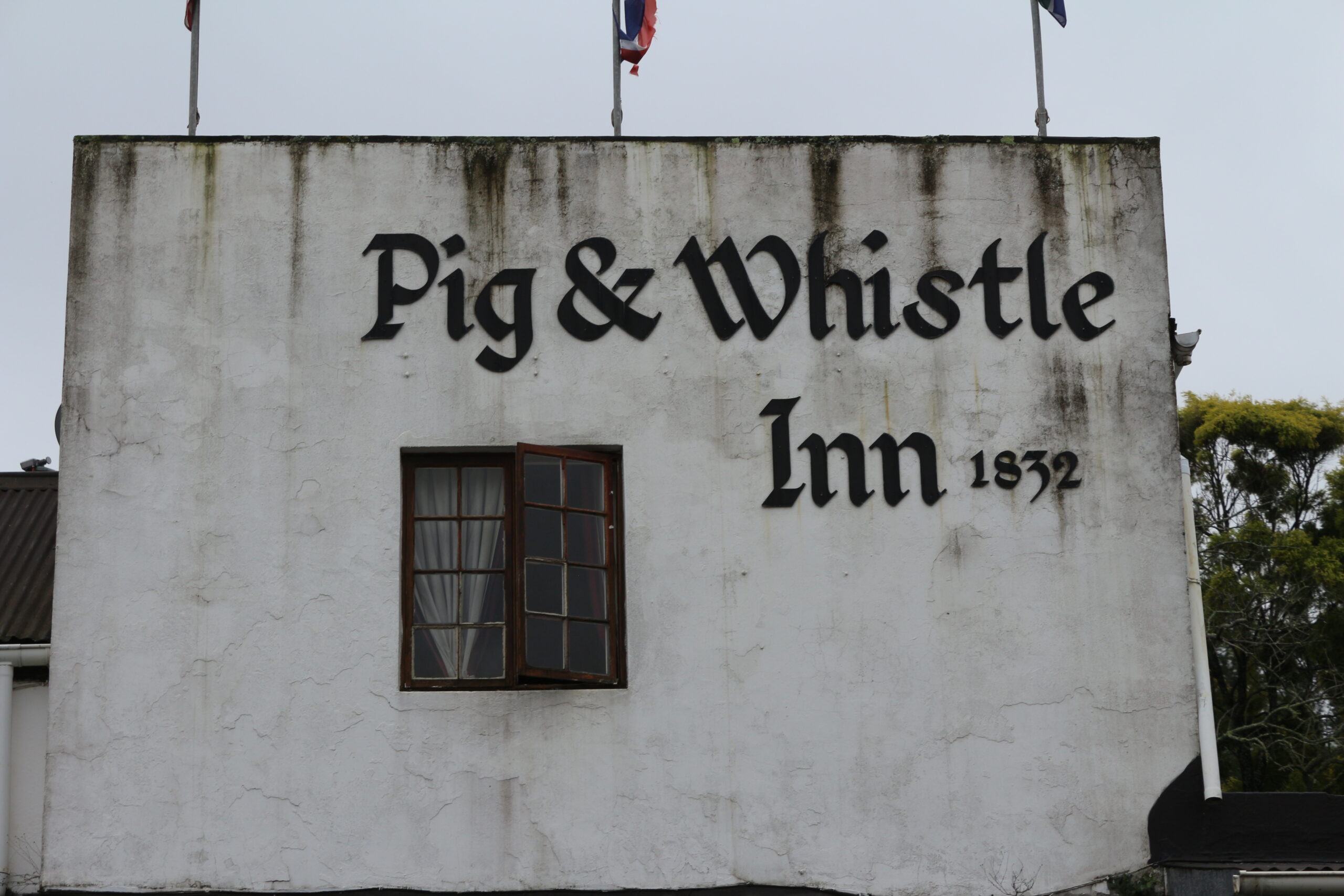


The Pig and Whistle in Bathurst was still going strong, having being established in 1832! We stopped there for a short while and took some pictures before continuing on our journey to Groot Brakrivier for our last night’s stay. On the way Wilfried asked my mother what the naughtiest thing was that she did at school. My mom laughed, and then told him how she released a pencil box full of grasshoppers during the girls’ choir practice!
27th March 2024: Groot Brakrivier

My mother had forgotten some cosmetics under her pillow in her room at Port Alfred, so we popped in at the The Beach House again en route to pick them up. The engaging “Isabeau” was delighted to see Wilfried again! She told my mother that had my mom left millions under her pillow she is not sure that she would have informed us that she had found them! The delay in Port Alfred meant that we arrived late at our next stop, Seeplaats in Groot Brakrivier. Negotiating the stretch from Knysna to George was difficult as it was raining heavily, the roads windy, there were extensive roadworks, and the visibility was poor. We arrived in Seeplaats after the restaurant was closed, so we had to go into the village in search of supper. We ended up at a relaxed local eating place, Searles Village, where I ordered twelve peri peri prawns. They were kings, and quite delicious! The locals spoke Afrikaans and it was interesting to see how much Wilfried understood of their conversation. At the end of the evening we discovered that the one family was from the Vereeniging – Vanderbijlpark area and they had moved to Groot Brakrivier to give their children a better and safer environment. This made me think of my mother’s short story that she wrote called “The Yellow Hula hoop”, (published in Contrast: South African Quaterly: December 1974, Vol 9, No.3), where she tells us what the old car numberplate code for Vanderbijlpark, “TVB” stands for: “Te Veel Babas, Te Veel Brandewyn, Te Veel Baklei” (“too many babies, too much brandy, too much fighting”). He found this very amusing and wished us well.
We spent the night with the sound of the ocean waves crashing on the beach near by, it poured with rain and the gushing wind made the vines growing next to the house scratch against the corrugated iron rooftop. Wilfried was convinced there was a creature, maybe a large monkey, maybe the Tokoloshe, in the room. When we turned the lights on, we saw the ties of the blinds banging against the wall behind a large fan on a stand, mimicking the form of a small man in the dark!
The next day, after breakfast, we continued our way back to Cape Town. We stopped at Swellendam to fill up with petrol and to visit my fat titmouse looking down on us from his glorious chandelier. At the Astron petrol station I saw a notice “Give light and people will find the way”. Back in Cape Town I noticed that all the street lights are on in the day – apparently due to the confusion caused by load shedding. I have been finding my way. I had explored some of my British and German South African origins and found that the light has kept shining through the generations.
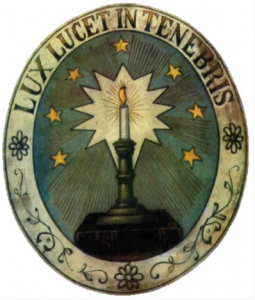
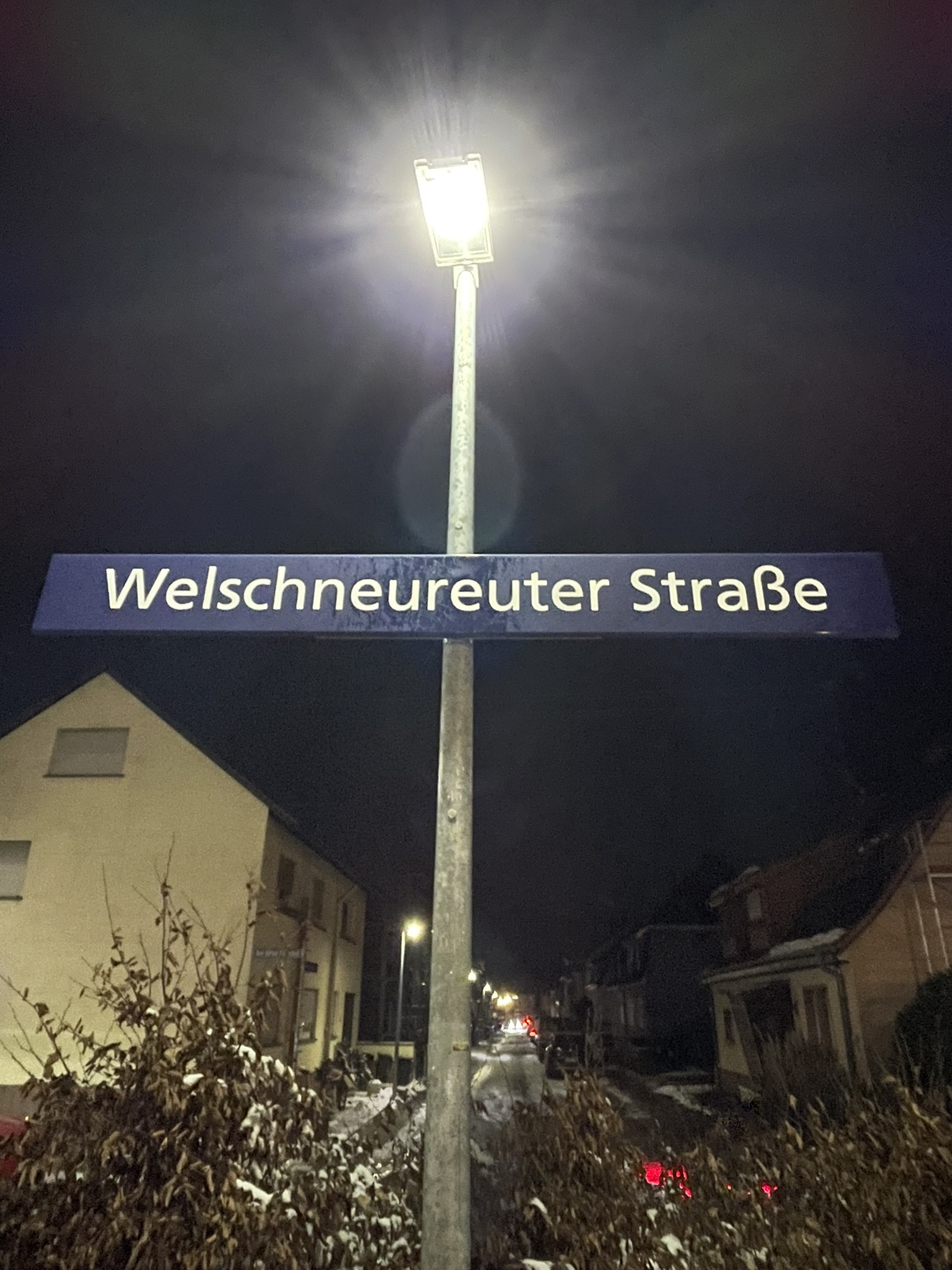


Very nice account of white paranoia in Africa…don’t go to the cemetery and remember to say banana and Dutch paranoia in Africa…big light dogs are interpreted as lions! – Gavin Clur
If you look on the lower right hand corner of the painting of 37 Alfred road (the original )
You will find a date..1965. There is no need for doubt.